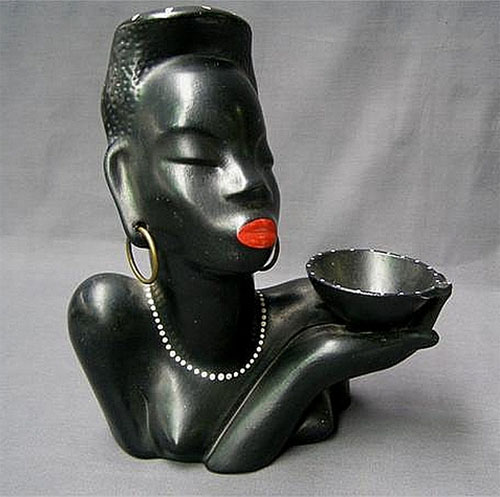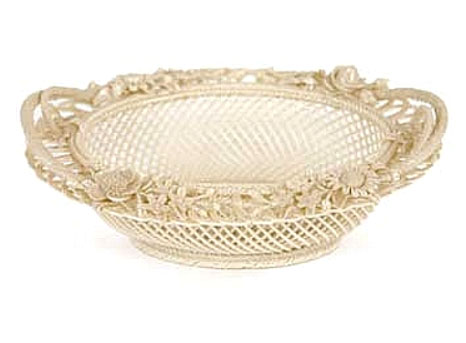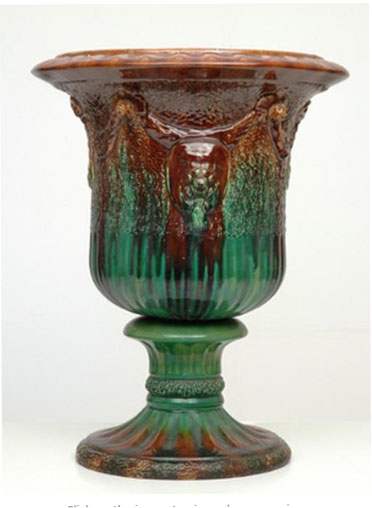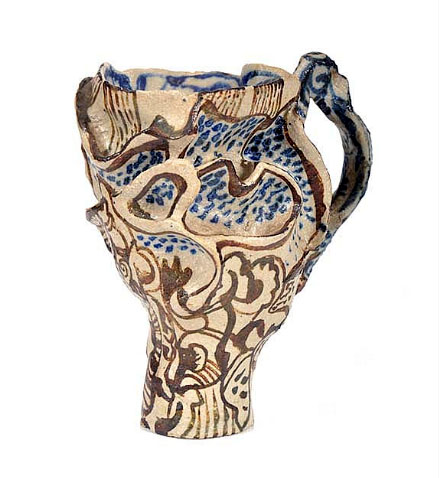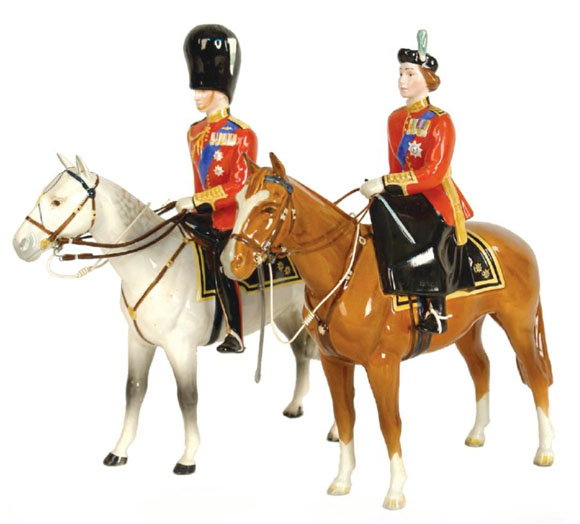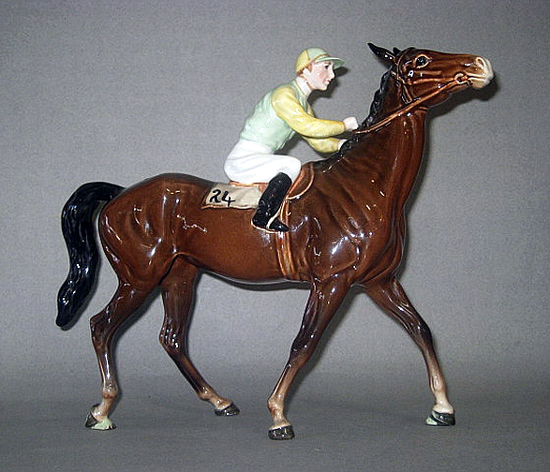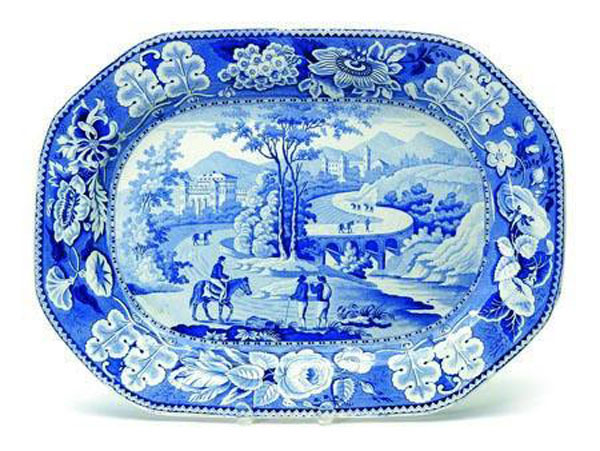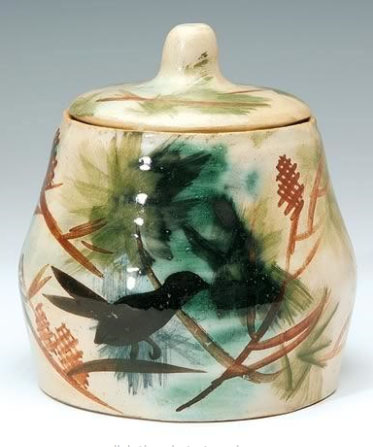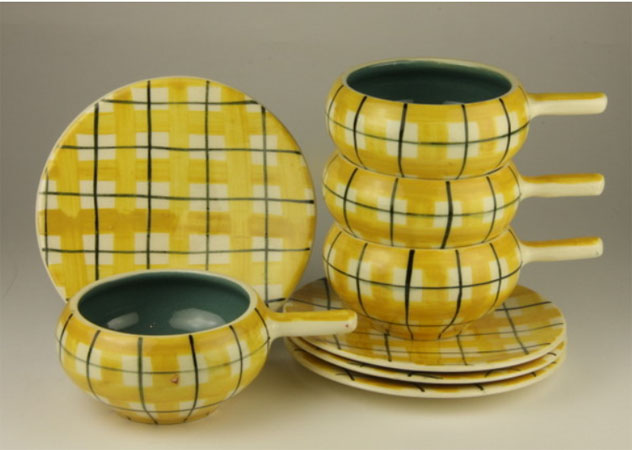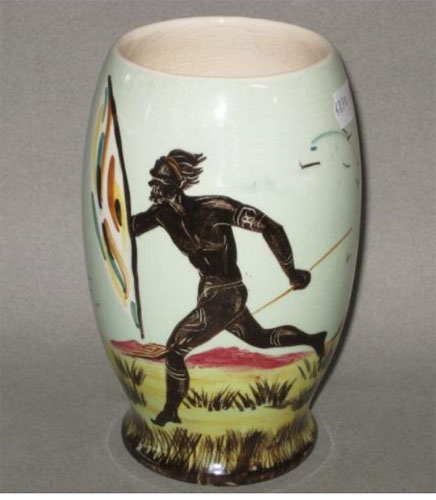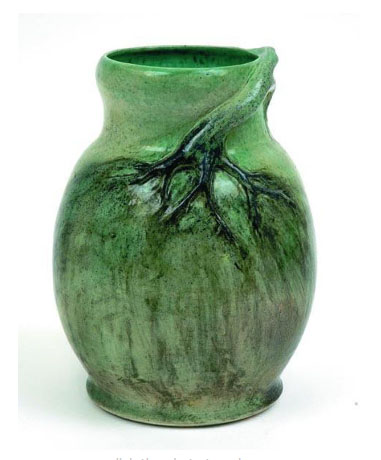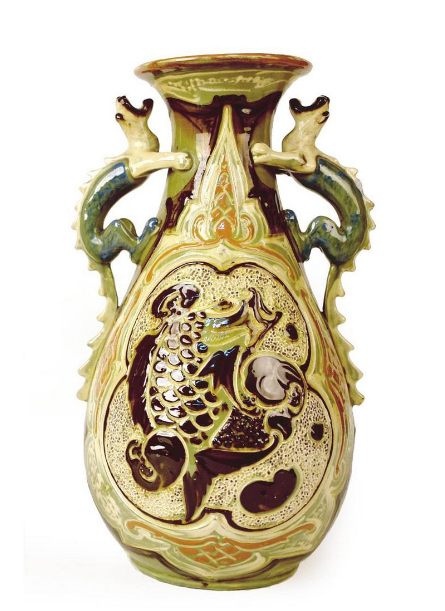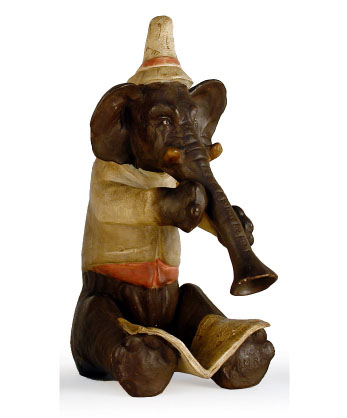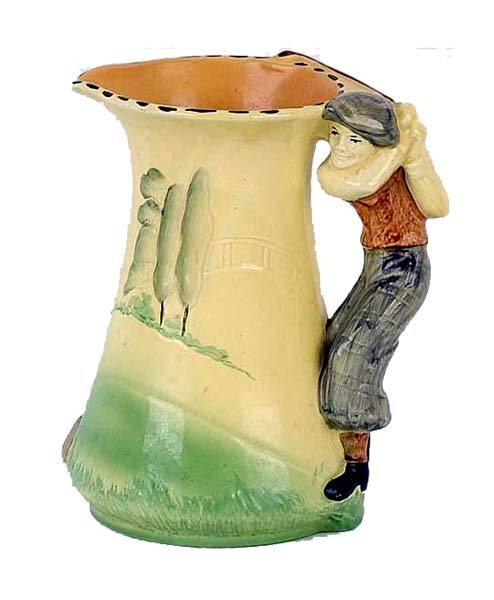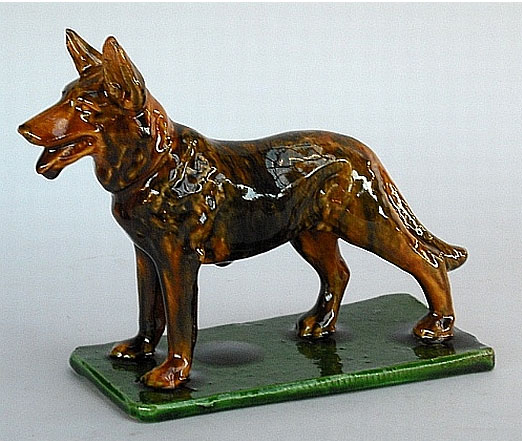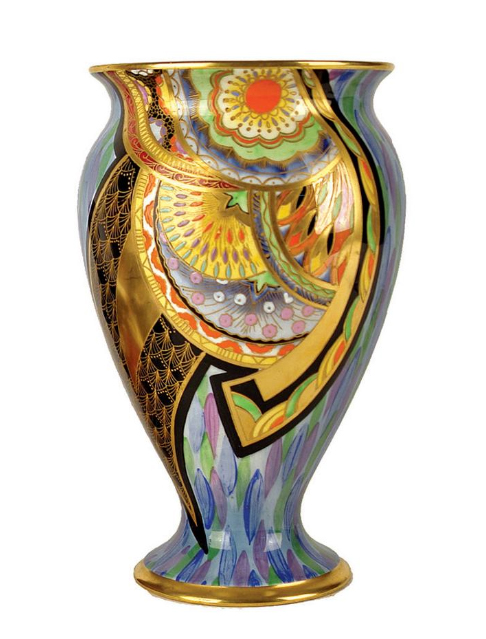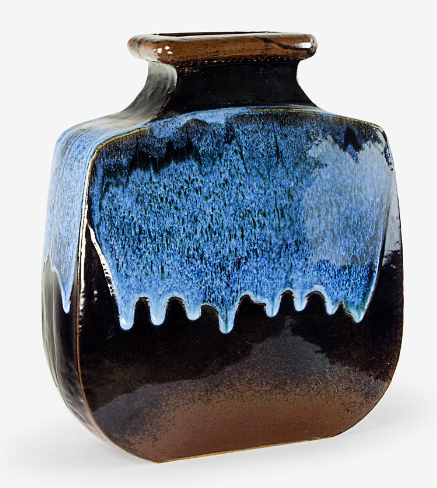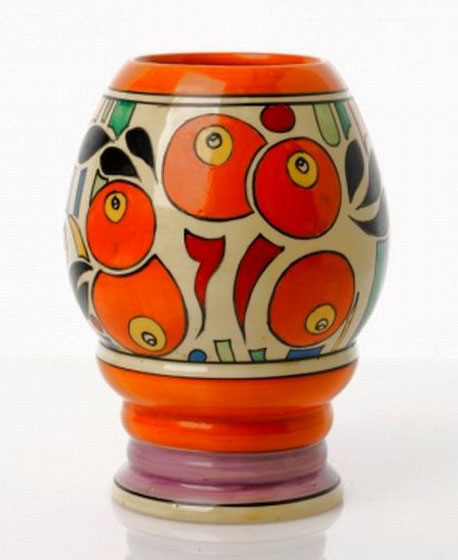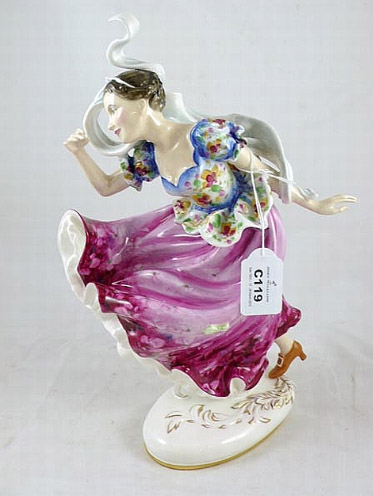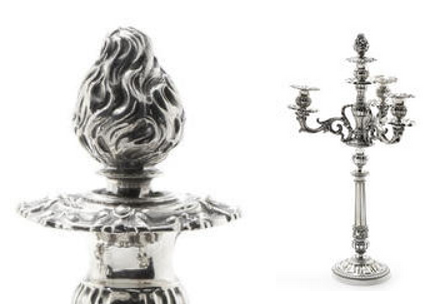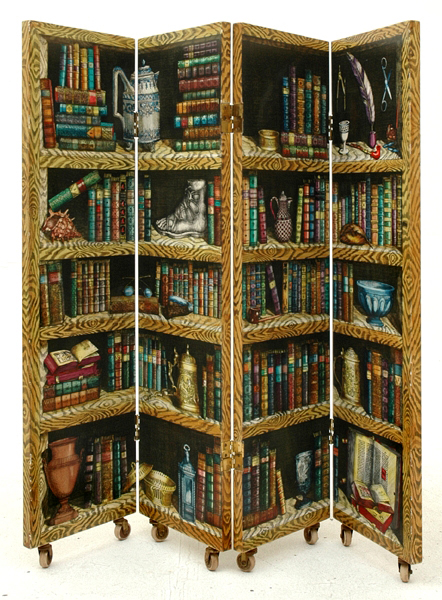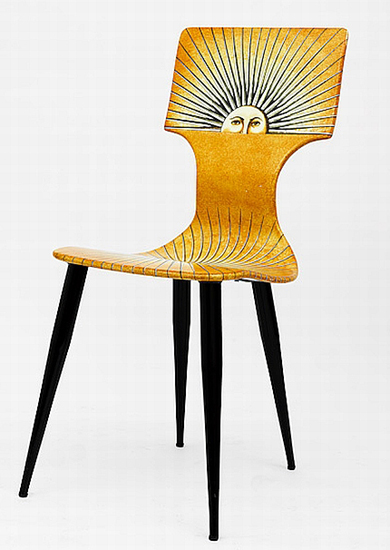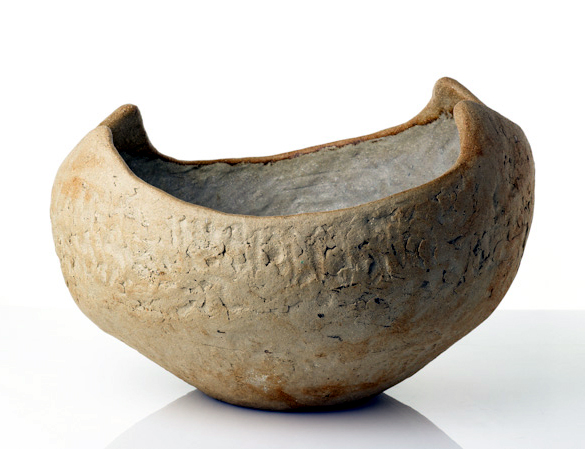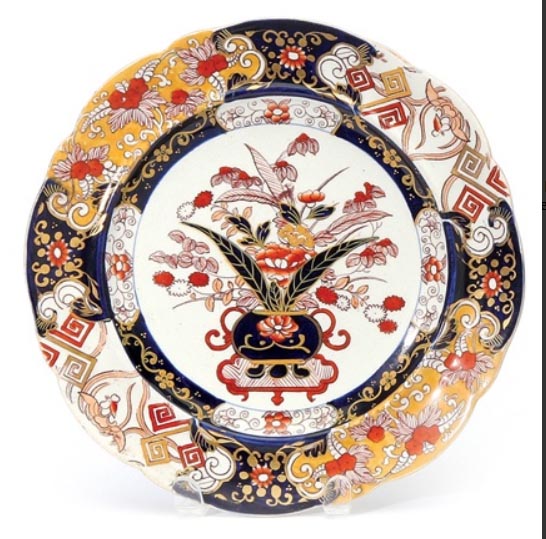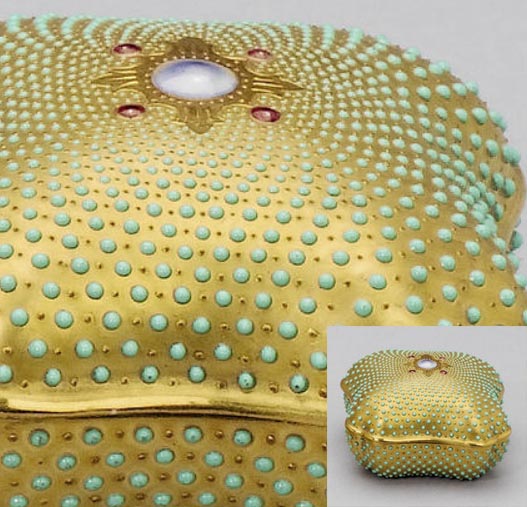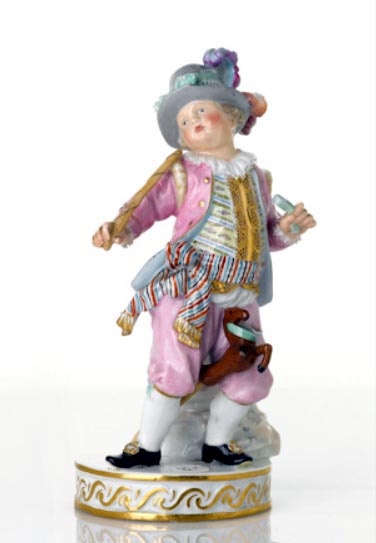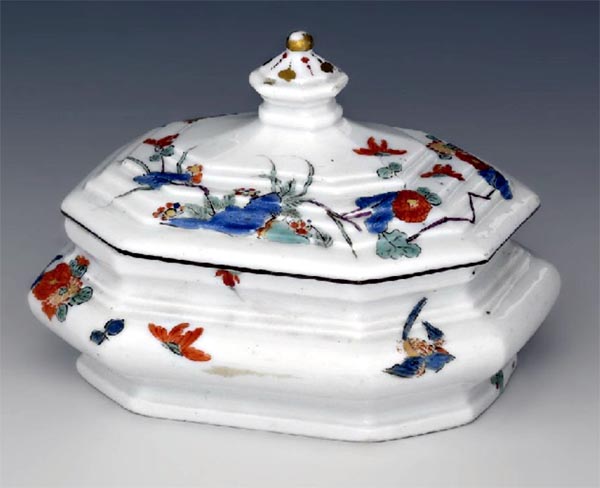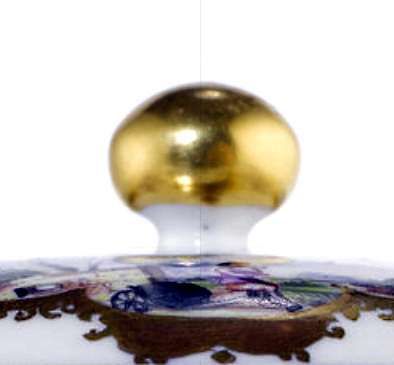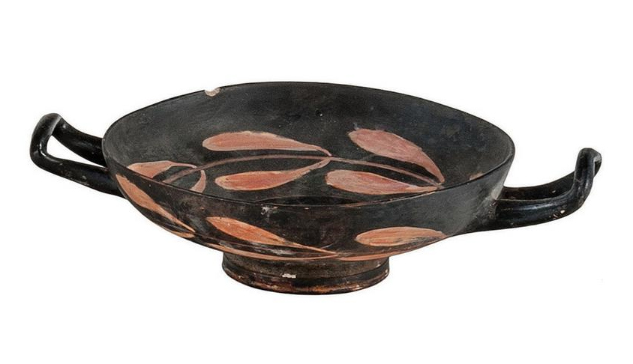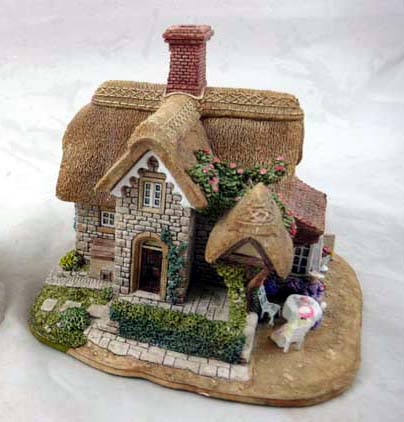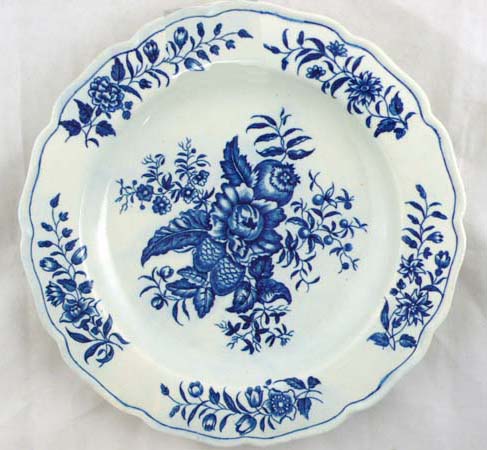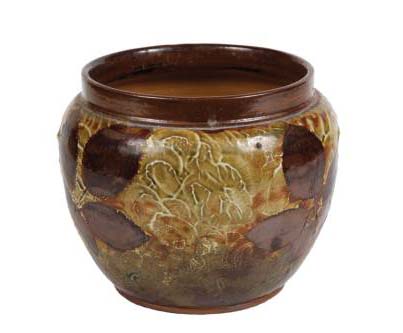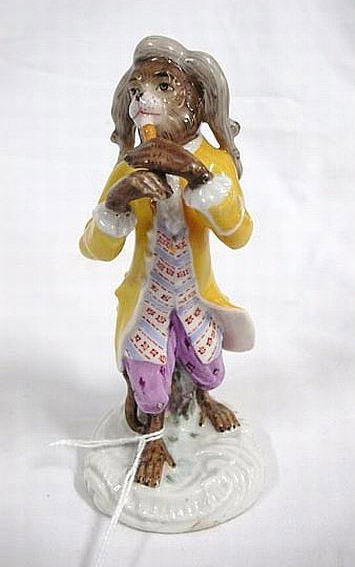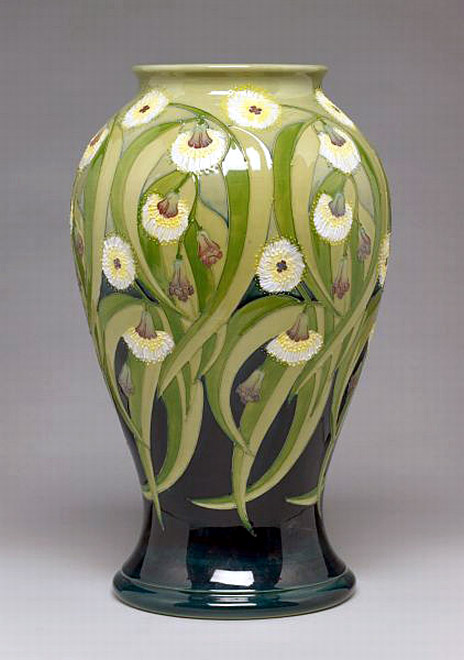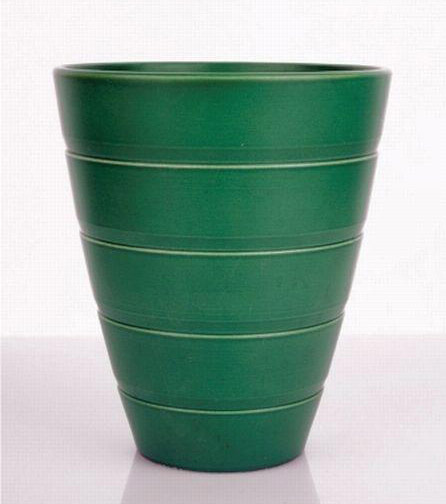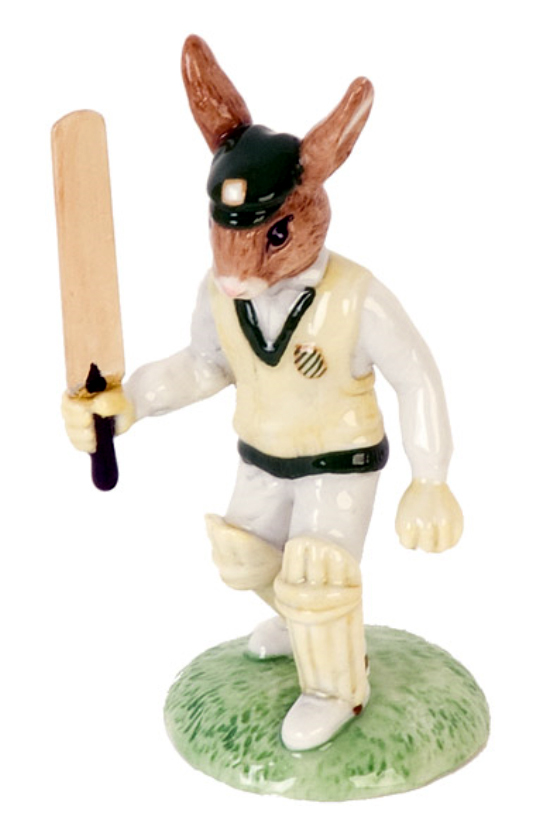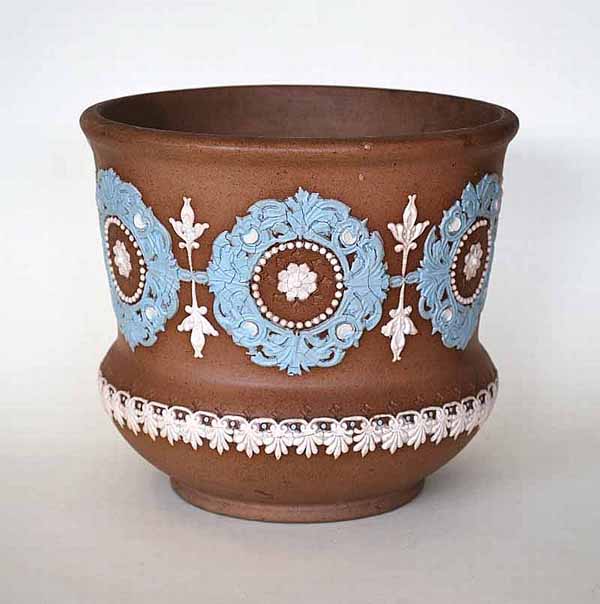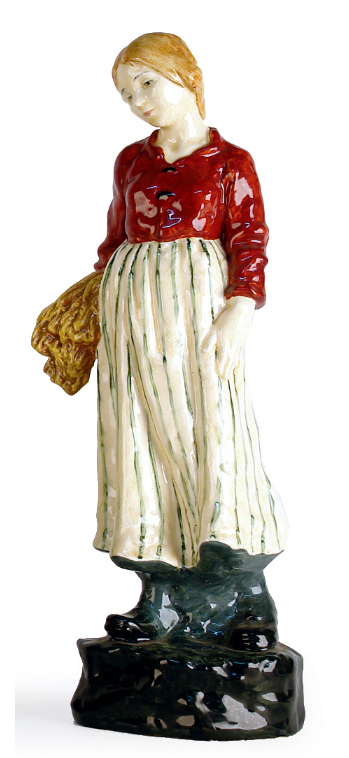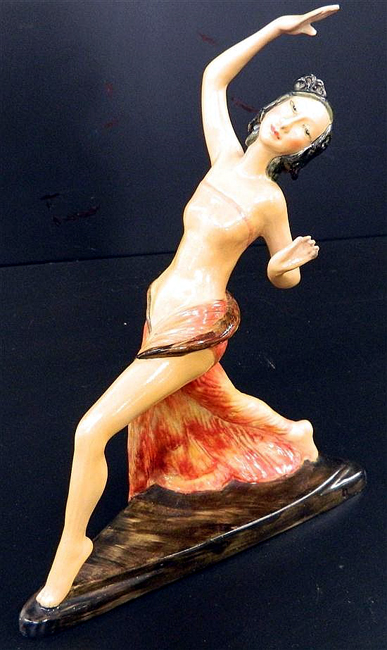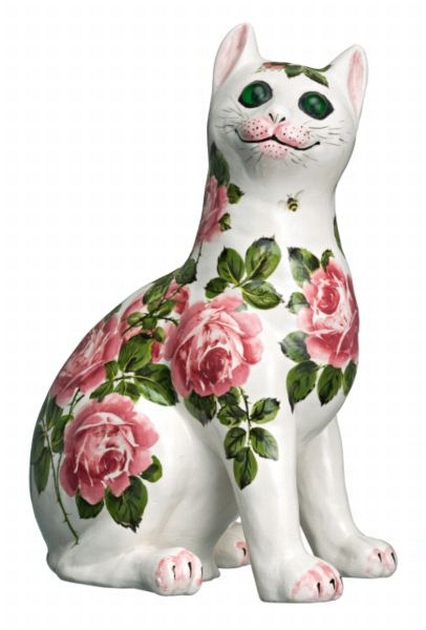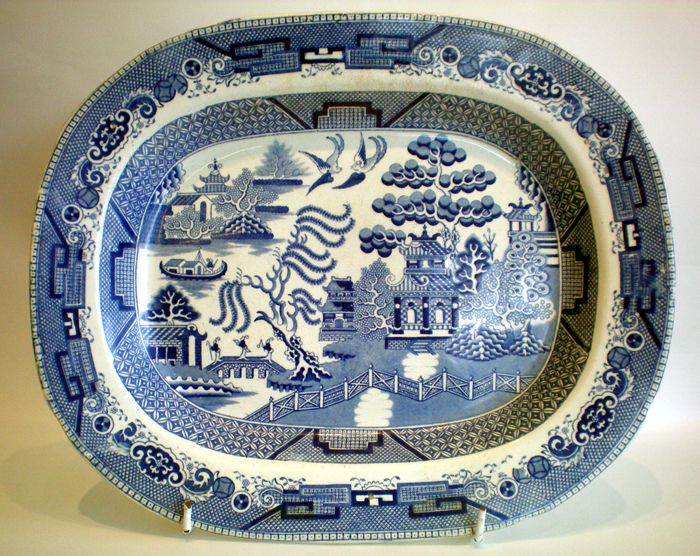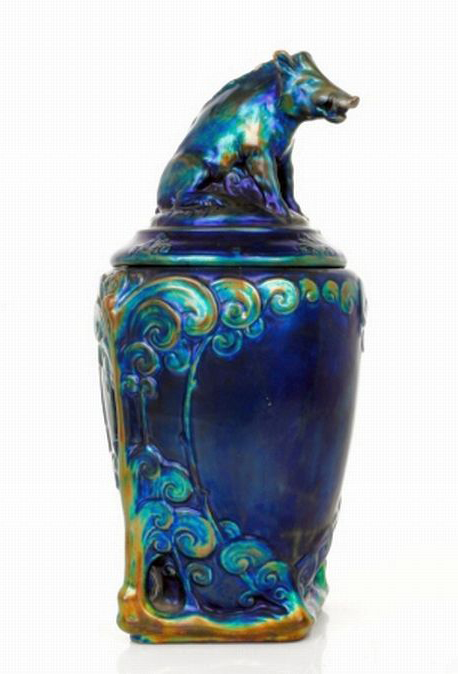Learn about antiques and collectables...
Click on a category below to show all the entries for that category.
Learn about and understand the items, manufacturers, designers and periods as well as the specialist terms used in describing antiques and collectables. Either click one of the letters below to list the items beginning with that letter, or click on a category on the left side of the screen to list the items under that category.
Adams Family of Potters
There were three potters with the name William Adams from different branches of the Adams family of potters working during the eighteenth and nineteenth centuries with some overlapping of production dates. The first was William Adams (1748-1831) of Brick House whose production was not prolific. The second William Adams (1772-1829), was born in Stoke-on-Trent and produced flow-blue ware for the United States market, and the business was continued by his son William (1798-1865). The third, from another branch of the Adams family was William Adams (1746-1805) who was born in Greengates, after reputedly working with Wedgwood. He founded the Greengates Pottery which specialised in the production of creamware and wares that imitated the Wedgwood dark blue jasper ware. On his death the business was taken by his son Benjamin. The pottery was closed in 1820 due to the ill-health of Benjamin. The busines was sold outside the family in 1826 but was repurchased by another branch of the Adams family in 1897. It was taken over by the Wedgwood group in 1966. Production of ceramics under the Adams brand ceased in 1998.
Adderleys Ltd.
Adderleys Ltd. pottery was opened at Longton, Staffordshire in 1906 producing china and earthenware. From c.1936 to 1988 Adderley operated 'Adderley Floral and Figurine China Co Ltd' , and in 1947 was taken over by Ridgway Potteries but continued production under the Adderley brand. In 1973 Ridgway Potteries and their subsidiary companies including Adderleys was acquired by the Royal Doulton Group.
Arabia Ceramics
Arabia, the Finnish ceramics manufacturer was established in 1873, by the Swedish company Rorstrand, itself a ceramics manufacturer since 1726. The name Arabia was derived from the Helsinki district in which the first factory was located, Arabianranta.
Manufacturing commenced in 1874 with assistance from skilled Rorstrand staff, with the primary market being Russia. Production facilities expanded in the late 1880s and 1890s with about one third of output destined for the Russian market.
In the 1900s export sales began to fall due to higher production costs and import duties in the destination countries and Arabia concentrated on domestic sales.
The company was sold in 1916 to Finnish investors and a program of modernisation and additions to the plant was undertaken. There were a number of ownership changes in the 1920s with the end result that Arabia, Rorstrand and another Swedish porcelain manufacturer, Lidkoping becoming part of the one group.
By the 1930s Arabia was the largest porcelain manufacturer in Europe.
In 1990 Arabia was acquired by the Finnish company Hackman, manufacturers of stainless steel kitchen ware, who also owned the Iittala and Rorstrand brands. Further ownership changes saw the Hackman brands acquired by leading Finish consumer goods company Fiskars, who as well as the Hackman brands also own the Gerber, Royal Copenhagen Wedgwood and Waterford brands.
Ashby Potters' Guild
Ashby Potters' Guild was an English studio pottery that opened at Woodville, Derbyshire in 1909, established by Pascoe Tunnicliffe. It closed in 1922 when it merged with the Ault Faience Pottery to form Ault and Tunnicliffe. Ashby Potters' Guild was active in the production of high end decorative wares.
Aynsley China Ltd. (formerly J. Aynsley & Sons)
Aynsley China Ltd. is a British manufacturer of bone china tableware, giftware, handpainted figurines and animals and commemorative items. The company was founded in 1775 by John Aynsley in Lane End, Longton, Staffordshire. In 1861 his grandson John Aynsley built the historic Portland Works on Sutherland Road, Longton, Staffordshire.
Commemorative wares to mark Royal occasions were popular line of the company, reaching their peak with the Aynsley designed dinner service being selected from 15 entries by Princess Elizabeth for her wedding. The design was then marketed commercially as the 'Windsor" pattern.
The company's profitability from sales of its tableware, giftware and commemorative items made it a desirable acquisition and in 1970 John Aynsley and Sons was taken over by Waterford and renamed Aynsley China Ltd.
In 1987 there was a management buyout of Aynsley China Ltd. and then in May 1997, Aynsley China was acquired by The Belleek Pottery Group of Ireland.
Due to rising costs at its Sutherland Road factory, and falling sales, the company closed its Stoke-on-Trent factory in December 2014 ending 239 years of manufacture in Staffordshire.
Production of Aynsley China was outsourced to China.
View further examples of Aynsley China Ltd. (formerly J. Aynsley & Sons)
Bailey, Lorna
Lorna Bailey was born on 10th February 1978 and was brought up in Newcastle-under-Lyme, Staffordshire.
She has lived throughout her life in and around the Newcastle-under-Lyme area, and it is this area from which the majority of the names for her designs are taken.
She attended Stoke-on-Trent College leaving with a Blec National Diploma in Design (Ceramics). Stoke-on-Trent College is the successor to the Burslem School of Art where Clarice Cliff, Susie Cooper, Charlotte Rhead and Fredrick Rhead and Mabel Leigh amongst others, all studied.
Her designs are manufactured by L. J. B. Ceramics, where she worked while still studying at college. Lorna Bailey's bold, striking designs are often compared with those of Clarice Cliff
Barsony
Barsony Ceramics, synonymous with the production of matt black coloured ceramics from the 1950s and 1960s, was an Australian ceramics manufacturing company operated by George Barsony (1917-2010) and Jean Barsony from the early 1950s to the early 1970s.
George Barsony, a sculptor from Hungary had arrived in Australia as a refugee in 1949 and shortly after, met his future wife Jean who had come to Australia from England and worked in a Sydney pottery.
Together they set up Barsony Ceramics, and the company's operations were conducted from a factory Guernsey Street, Guildford in Western Sydney from the 1950s to 1970s.
As well as manufacturing under the Barsony name, Barsony Ceramics also produced items under the Silver Cloud and Venice labels, but items under these labels very rarely come onto the market.
Decorative items produce by Barsony included candlesticks, figurines, lamp bases, ashtrays, wall hangings, bookends, figure vases, bowls etc.
Most Barsony products were marked, although there are some that have no markings. As well there are copies of Barsony products that are unmarked, and a range of similar items were made by Kalmar.
Genuine Barsony can be identified by the numbering system on the base of the item: 'H' indicated head, 'V' indicated vase', and 'L' indicated 'lamp'. Thus 'FL' indicated a figural lamp and 'HL' indicated a head lamp. These letters are followed by the model or mould number. Many of the lamps and figures are named models, such as 'Drumbeat of Trinidad' (FL-41), 'Beauty of the Beach' (F-19) and 'Sitting Black Lady' (FL39). Kalmar items had a similar marking system and it is often difficult to distinguish between the two manufacturers.
The most recognisable Barsony product are the "black lady" lamps, featuring a scantily dressed figure with red and white highlights, and collectors are able to distinguish between original shades that came with the lamp, and later replacements. The price of a lamp will be boosted if it has the original shade which, often were of plastic ribbon and raffia trimmed with thin velvet ribbon. Some of the lamp bases even had built in ash trays but the inclusion of the ashtray was a monetary not a design consideration. At that time a high sales tax was levied on ornamental items, while utilitarian items such as cups, plates and ashtrays attracted a reduced sales tax.
Belleek
The Belleek porcelain factory was founded in County Fermanagh in Northern Ireland about 1849, after landowner John Caldwell Bloomfield inherited his father's estate, and undertaking a geological survey, discovered the area was rich in minerals.
Bloomfield went into partnership with a London architect and a Dublin merchant and set up a pottery business to provide work for the tenant farmers whose lives had been decimated by the Irish potato famine.
The construction of the pottery commenced in 1858, and it included a railway line to the works, so coal could be delivered for the kilns.
The company commenced producing domestic wares, but it wasn't until 1863 that small quantities of the translucent ivory-looking porcelain for which Belleek is famous, were produced.
Belleek was popular with Queen Victoria and was displayed at the great 19th century exhibitions, and enjoyed a large export market.
Typical Belleek items include figures, vases, dishes, eggshell-thin tea services, and baskets, often with delicate open lattice-work. Marine motifs were commonly used including Neptune, shells, seaweed, mermaids, dolphins and coral and wares.
The history of the factory's output can be identified by the type and colour of the marks. A black mark was in use from 1863 to 1946 and this was superseded by a green mark. The green mark continued in use until 1980, and this was followed by a series of colours used for only short periods: gold from 1980 to 1992; dark blue from 1993 to 1996; light blue from 1997 to 1999; black again in 2000; green from 2001 to 2006; black in 2007 and then brown from 2008 onwards.
The company has changed ownership a number of times since 1884, by which time the three original owners had died, and is currently owned by Irish born American entrepreneur, Dr George G. Moore. Belleek has rebranded from the ornamental porcelain with shamrocks for which it is famous to more commercial everyday pottery through its Belleek Living range.
When buying, condition should always be checked, as Belleek objects are easily damaged due to the delicacy of the designs.
Bendigo Pottery
George Guthrie, a former Glasgow potter founded the Bendigo Pottery at Epsom near Sandhurst (as Bendigo was then called) in 1858.
It was not surprising that an important pottery was established at the gold?clds, particularly as the Victorian miners had discovered good clay-fields in the course of their search for gold. Guthrie had arrived from Scotland to try his luck on the goldfields, and as a potter by trade recognised the potential of clay discoveries. .
At the 1866 Melbourne Exhibition, Guthrie was a medal winner for his collection of stonewares, particularly brown ginger-beer bottles.
Domestic and table wares were added to the range of pots and bottles. Brown ‘Rockingham' teapots, cups and saucers, decorated cream-ware jugs and basins, white parian ware ornaments, majolica vases and artistic water filters were amongst the products.
In the early 1880s Guthrie sold the pottery and returned to Scotland . He returned after a year or so, later, became managing director and then with a partner re-purchased the pottery.
He remained the driving force behind the pottery until his death in 1910.
Many of the early Bendigo wares are unmarked, one reason for this being that the public preferred to purchase imported goods.
The pottery at Epsom is still in production today, and there is a museum at the pottery that displays a selection of the early wares
Benwell, Stephen
Stephen Benwell was born in 1953 in Melbourne.
He studied at the Victorian College of the Arts and Melbourne State College.
in the mid 1970's he travelled and studied in the USA and Mexico and 1984-5 he was resident in Paris at the Cite lnternationale des Arts.
His first solo exhibition was at The Craft Centre, South Yarra in 1975 and since then has participated in many solo and group exhibitions.
He is represented in the Art Gallery of South Australia, Art Gallery of Western Australia, Australian National Gallery, Canberra Museum of Applied Arts and Sciences, Sydney National Gallery of Victoria, Newcastle City Art Gallery, NSW Queensland Art Gallery, Shepparton Art Gallery, and the Tasmanian Museum and Art Gallery, Hobart.
Beswick
From the establishment of the Beswick factory in Longton, Stoke on Trent in 1894, animal figures of a very high quality and at an affordable price to the collector with a modest budget. have been represented in Beswick sales catalogues and advertising material. The production of Beswick figures can be divided into two periods.
From the 1890's to the mid 1930's the Beswick factory produced, in the Staffordshire traditional form, a combination of table ware, decorative porcelain, majolica and a range of figures and animals such as generals, milkmaids, mantle dogs, cattle and horses. Critics of the time described their models to be of a higher quality than those of their precursors. Unfortunately for collectors, Beswick followed the early Staffordshire tradition of not marking their figures and as a consequence, it is very difficult to identify the names of the modellers, designers and artists from that period until the 1930's.
In 1934 after the death of his father, John (Ewart) took over as managing director and moved the company away from the production of tableware to placing a greater emphasis on figurines. And most importantly for collectors, introduced a 'shape book' and a systematic numbering catalogue recording the impressed mark and backstamp on the full range of Beswick products.
They also appointed Arthur Gredington as the company's first full time modeller in 1939. The combination of these two events created the golden age of Beswick which continued until the factory closed in 2002.
Beswick was a tight knit family firm which was renowned for its ability to produce high quality traditional Staffordshire figures and table ware from its formation in 1894. By the time John (Ewart) Beswick took over as Managing Director in 1934 the firm had prospered under three generations of Beswick management.
John, along with his Uncle Gilbert who worked alongside with him as Sales Director, worked to change the direction of the company from producing tableware to the production of figurines. This required the recruitment of a modelling team. In 1939 Arthur Gredington was appointed as the company's first full time modeller.
This was an inspired choice as the team of Ewart, Gilbert and Arthur Gredington created the Beswick golden age, which lasted to the 1990's, long after all three had left the Company Arthur Gredington's influence at Beswick was enormous. He had a great talent for modelling with his accurate and realistic creation of animals of all kinds such as horses, dogs, cats, birds, wild animals, farm animals, fish and more all of the highest quality.
He also displayed versatility and humour with his design of the wide range of Beswick story book figurines where he gave human characteristics to the story book animals. Gredington designed and modelled the first Beatrix Potter figurines in 1947 and from this base, Beswick produced a vast array of cartoon figures, character animals, Brambly Hedge and other story book figures.
Arthur Gredington retired in 1968. Ewart and Gilbert Beswick, with no successors to take over the business, sold to Royal Doulton in 1969. However, such was his skill and talent, that many of Gredington's models remained in production to ensure that the Beswick factory continued to produce the highest quality figurines until the factory closed in 2002.
Beswick Figurines
From the establishment of the Beswick factory in Longton, Stoke on Trent in 1894, animal figures of a very high quality and at an affordable price to the collector with a modest budget have been represented in Beswick sales catalogues and advertising material.
The production of Beswick figures can be divided into two periods.
From the 1890's to the mid 1930's the Beswick factory produced, in the Staffordshire traditional form, a combination of tableware, decorative porcelain, majolica and a range of figures and animals such as generals, milkmaids, mantle dogs, cattle and horses.
Critics of the time described their models to be of a higher quality than those of their precursors.
Unfortunately for collectors, Beswick followed the early Staffordshire tradition of not marking their figures and as a consequence, it is very difficult to identify the names of the modellers, designers and artists from that period until the 1930's.
In 1934 after the death of his father, John Ewart took over as managing director and moved the company away from the production of tableware to placing a greater emphasis on figurines, and most importantly for collectors, introduced a 'shape book' and a systematic numbering catalogue recording the impressed mark and backstamp on the full range of Beswick products.
They also appointed Arthur Gredington as the company's first full time modeller in 1939. The combination of these two events created the golden age of Beswick which continued until the factory closed in 2002.
Blakebrough, Les
Les Blakebrough was born in 1930 in England.
He studied ceramics at East Sydney Technical College.
From 1960 until 1972 he was manager of Sturt Pottery, Mittagong, NSW, later becoming director of Sturt Craft Centre.
In 1963-4 he studied in Kyoto, Japan with Takeichi Kawai.
He was a foundation member of the Crafts Board of the Australia Council.
In 1973 he joined the staff of the Ceramic Department, School of Art, Hobart, and established a private workshop at Mt Nelson. He has conducted workshops in all Australian states, New Zealand and the USA on a regular basis since 1975.
He is represented in all Australian state galleries, the Australian National GaIIery, Canberra, Ballarat and Shepparton Regional Galleries, the Queen Victoria Museum and Art Gallery, Launceston and Tasmanian Museum and Art Gallery, Hobart.
Blanc De Chine
‘Blanc de Chine’ literally translates as "white from China". The pieces are made from a pure, white porcelain with a very smooth glaze and have been made since the 16th century to the present day, at the kilns in Dehua in the Chinese province of Fujian.
Large quantities of Blanc de Chine’ were exported to Europe as Chinese export porcelain in the early 18th century and Blanc de Chine was copied by European potteries including Bing & Grondahl, Herend, Meissen, Royal Copenhagen, Royal Worcester and others. It was also exported to Japan in large quantities.
The most common shapes are devotional objects including small figures of Ho-tai (Buddha) and Guanyin, the Chinese goddess of mercy. Early pieces tend to have a warmer, ivory tinge, whilst later pieces are ‘colder’ white or have a blue tinge.
Bleu Celeste
"Bleu céleste" is a French term that translates to "sky blue" in English, and it refers to a specific shade of blue pigment used in the decoration of porcelain. This color is a light, sky-blue shade that was often used in combination with other colors to create intricate designs on porcelain pieces. The use of "bleu céleste" was was first used by the Sèvres porcelain factory in the 18th century, and became popular in the 19th century. The colour is created by adding copper oxide to the glaze. It was valued for its ability to add a touch of lightness and delicacy to porcelain designs. The color was often used to create floral motifs, landscapes, and other decorative elements, and it was prized for its ability to evoke feelings of calmness and serenity.
Bleu De Roi
Bleu de roi is a deep blue colour used in porcelain decoration, specifically in the decoration of French porcelain. It is similar to, but darker than the colour "Bleu Celeste" and it was first used by the Sèvres porcelain factory in the 18th century. The colour is created by adding cobalt oxide to the glaze. The name Bleu de Roi comes from the French for "King's Blue," and it was favored by King Louis XV of France.
It was one of the colours used to decorate the most elaborate and luxurious pieces, and was used to create intricate designs and patterns, including flowers, landscapes, and figural scenes.
Blue & White
Blue and white patterns became popular in China in the early 14th century during the Ming Dynasty and were hand painted.
The majority of the blue and white ware found and collected today in Australia is of English and European origin and dates from the late 18th century onwards, when the development of transfer-printing led to a huge expansion in production.
Chinese scenes, floral motifs, scenes incorporating classical architecture and pastoral themes are prevalent.
Blue and white ware was not made by a single maker, but was produced by many factories, with Spode and Wedgwood being the most prolific. Much blue and white ware was made by Staffordshire factories and is unmarked.
Plates are probably the most widely collected form as the surface shows the pattern to its best advantage. Platters and dishes are also popular for the same reason, but are larger and take up more display space.
The pattern depicted will affect value and desirability – a plate with the ‘Willow’ pattern will be worth less than one with a rarer design. Size is also important – large pieces are usually more valuable, but certain shapes are rarer and therefore more desirable.
Bocage
The name given to floral and leaf decoration usually surrounding the main subject in ceramic figures and groups, commonly on 18th century porcelain from the Derby, Bow and Minton works.
Bonbon Dish
A bonbon dish is a type of serving dish that is specifically designed to hold small, bite-sized candy or chocolates, which in the 19th century were also known as bonbons. They were often used for special occasions, like parties, weddings and holidays. They are also a common serving piece for after-dinner desserts, such as chocolates.
These dishes are often decorative and can be made from a variety of materials such as silver, glass, crystal, metal, or porcelain. Bonbon dishes come in many different shapes and sizes, but most are relatively small, and have a shallow bowl or dish shape.
Bone China
Bone china, Also called 'English china", is one of the three types of porcelain, the other two being soft paste porcelain and hard paste porcelain.
Porcelain is an ancient ceramic material, first made in China, hence the common name "china", and the introduction of bone china was to counter the imports of Chinese porcelain.
The initial development of bone china is credited to Josiah Spode, who introduced it around 1800 and it was soon after copied by other manufacturers including Minton, Coalport, Davenport, Derby, Worcester, Wedgwood and Rockingham and the Herculaneum factory at Liverpool.
Spode's bone china was made by mixing ash from cattle bones with feldspar and kaolin, which created a material that was stronger, more translucent, and whiter than traditional porcelain. He began to produce this new type of porcelain in 1796 and it quickly became very popular.
At the time, the process and ingredients were kept secret and were only known to a few manufacturers and were protected by patents.
In the 19th century, bone china became increasingly popular and was widely produced by many manufacturers in England. During this time, it was considered a luxury item and was often used to create fine dining sets and other decorative items.
Bone china is still used in the production of fine porcelain wares, such as tea sets, figurines, and other decorative pieces. His basic formula of six parts bone ash, four parts china stone, and three and a half parts china clay remains the standard English body. It is still considered a luxury item due to its strength, translucency, and whiteness, and is often used for high-end and high-quality porcelain. China.
Boss
A boss is small round or oval decorative device, used as ornament in Neo-classical style furniture, ceramics, sculpture and other decorative arts. They are usually applied to the surface in the form of stylized rosettes, but in the best pieces they are carved directly into the surface. Also known as paterae (or patera) or rosettes.
Boyd, Arthur Merric Bloomfield
A member of one of the most distinguished 'art' families of Australia. Born in 1920, he was instructed by his father, William Merric Boyd, in the art of ceramics, and painting in the Heidelberg tradition by his grandfather.
During the 1930's Boyd came into contact with the modern movement and was brought into touch with the Contemporary Art Society by Albert Tucker. One of Australia's most important artists, Boyd died in 1999.
Boyd, David
Born in Victoria in 1924, David Boyd is the son of William Merric Boyd. Following army service, he studied at Melbourne University Conservatorium of Music and at the National Gallery School.
His first distinction was as a potter, briefly with the Martin Boyd pottery, and later with his wife, Hermia. The pair held their first exhibition in Sydney in 1948.
His first serious painting commenced with the Explorer series in 1957. Since then he has held over 40 major exhibitions throughout Australia and in London and France.
David Boyd's paintings are widely represented in public and private collections in Australia, America and England.
David Boyd died in 2011.
Boyd, Guy
Born in Murrumbeena, Victoria in 1923, Guy Martin A'Becket Boyd was known as a potter and sculptor. After extensive training in the family pottery conducted by his father, William Merric Boyd, he moved to Sydney and founded the Martin Boyd pottery.
In 1965 he left the commercial pottery to become a full-time sculptor, holding his first exhibition in Sydney in 1966. He has since had over 20 exhibitions throughout Australia and London. Guy Boyd died in 1988.
Boyd, Merric
Born in Melbourne in 1888, William Merric Boyd, known as Merric Boyd, a sculptor, first studied drawing at the Melbourne National Gallery School.
After successful experiments in pottery he built a pottery at the family home at Murrumbeena, near Melbourne, and soon became recognised as Australia's first art potter. After a period with the Australian Flying Corps during World War I, he spent some time working in the Staffordshire Potteries in England and on his return to Australia consolidated his reputation as Australia's finest potter. He is still regarded as the 'father of Australian pottery'.
Ill-health forced him to give up pottery in later life and he then concentrated on drawing. A book of his later drawings was published in 1975. William Merric Boyd died in 1959.
Brannam Pottery
Brannam Pottery was founded by Thomas Brannam in Barnstaple in Devon in 1847 and made household items such as floor tiles, bricks and sewage pipes.
His artistic son Charles began work at the pottery at the age of 12 in 1867, and in 1879 he began to produce more fashionable art potter, which was often known as ‘Royal Barum Ware’.
Brannam's art pottery was decorated with carved and sgraffito patterns that revealed the red body of the objects.
Blue and green were the favourite glazes, and curving marine forms reflected the influence of Art Nouveau.
Charles Brannam inherited the pottery on his father's death, and in turn passed it to his two sons in 1913, who continued to be involved in the pottery until 1979.
The pottery continued oprating under the name of C. H. Brannam & Sons Ltd. Until it closed in 2005.
Bretby Art Pottery / Tooth & Co.
The Bretby Art Pottery, also known as Tooth & Co., was established in 1883 at Woodville in South Derbyshire, England, and the following year that the distinctive 'Sunburst' trade mark was registered
The early Bretby output had a close affinity to the Linthorpe pottery, where the founder of the company, Henry Tooth had previously been employed.
In the late 1880s, Bretby began producing a distinctive pottery known as 'Copperette', because it simulated hammered copper, and around 1900 Bretby commenced producing simulated bronze pottery, with imitation cabochon gems applied to the surface.
In the early 1900s, "Clantha ware" was evolved, with its distinctive black matt glaze, decorated in angular patterns.
Production at the Bretby Pottery declined in the early 1900s, and ceased production in 1920.
Burleigh Ware
Burleigh was founded in 1851 as Hulme & Booth in Burslem, Stafordshire, named after the founders, and then renamed ‘Burgess & Leigh’, after names of the new owners when the pottery changed hands in 1862.
Until the 1920s, it primarily produced toiletware, but expanded its tableware ranges in the 1920s and 1930s, and these are regarded as the firm's golden years.
The new brightly decorated, hand-painted and enamelled designs were very popular, with most patterns being designed by art director Harold Bennett. Other designers included Charles Wilkes, Ernest Baily and Charlotte Rhead who was employed from 1926 to 1931.
Their range of jugs with sculptural handles in the form of animals, birds and figures are as popular with collectors today as they were with the 1930s public.
The business was sold in 1999 and then again in 2010 when it was acquired by the company producing Denby Pottery.
Caberet Set
A cabaret set is another name for a small tea or coffee service, and usually consists of two cups and saucers, a small teapot, a sugar bowl, a cream jug and a tray.
Calyx Ware
Calyx Ware was produced from 1921 until the late 1930s by a pottery in Perth, Western Australia, originally named Calyx Porcelain and Paint Company, but undergoing several name changes.
The range was mainly functional items, often decorated with Australian themes. Archibald Bertram Webb (1887-1944) was a British artist who migrated to Western Australia and decorated some ACalyx Ware items.
After production of Calyx Ware ceased, the pottery produced the Wembley Ware range and then later 'Bristile'.
The trade name Calyx Ware was also used by the British pottery, William Adams & Co. from 1896 to the 20th century.
Campana Form Vases or Urns
Campbell's Pottery
John Campbell was born in 1857 in New Zealand and moved to Victoria with his family as a child. He became an apprentice at Bendigo pottery and his newly learned potters skills were rewarded by winning medals in the 1879-80 Melbourne Juvenile Intercolonial Exhibition for his exhibits - a stoneware fountain, a whisky still worm and two terracotta fire grate backs.
At around age 23 he moved to Tasmania and in 1881 in partnership with his father in law, bought Alfred Cornwell’s 'Victorian and Tasmanian Potteries Launceston pottery works. In the 1891-2 Tasmanian Exhibition in their home town of Launceston, Campbell’s exhibited a range of pots and urns, vases, teapots, cheese dishes with covers, jars, bottles and Toby jugs.
Pipe and brick manufacture was the largest part of the Campbell business, but John Campbell's own interest were the hand-thrown decorative items that they manufactured.
John Campbell died in 19129 and the business was taken over by his eldest son, Colin who continued the business. After his death in 1956 the business continued. However pottery sales were declining due to overseas competition, and input costs such as glazes were increasing and the pottery closed in 1959.
The pipe and brick manufacturing business closed in 1976.
Carlton Ware
The Carlton Ware works were set up about 1890 by James Frederick Wiltshaw, James Alcock Robinson & William Herbert Robinson in Stoke-on-Trent, and Carlton Ware was adopted as a trade name in 1894.
About 1890 the company introduced its "Blush Ware" range, with floral designs on delicate pastel coloured backgrounds, sometimes with gilded additions.
In 1911 the partnership was dissolved and James Frederick Wiltshaw became the sole proprietor.
During the 1920s, the company became known for its Art Deco lustre wares, which command high prices today.
Many of the patterns were of imaginative geometric and stylised floral designs, some using Egyptian and oriental influences, such as the highly collectable ‘Tutenkahmen’ and ‘Mikado’ ranges.
The "Handcraft" range introduced in 1928 offered modern freehand painted designs with matt glazes which distinguished them from other manufacturers of the time using similar designs.
Other later collectable areas of Carlton Ware are the high-lustre table ware in the "Royale" brand, including Bleu Royale and Rouge Royale introduced in 1949 and continuing through to the early 1970s, advertising wares, particularly those displaying the Guinness name, and the Walking Ware range of the 1970s, which was the company's last great success.
In 1966, following the death of Cuthbert Wiltshaw, the company was sold to Arthur Wood & Sons and continued to trade until it developed serious financial difficulties in the late 1980s, forcing it into receivership in 1989, resulting in it finally closing in 1992.
In 1997 the company's intellectual property and moulds were purchased by FJ Publications, which now produces objects for the collector's market.
Castle, Len
Born in 1924, Len Castle completed a Bachelor of Science degree at the University of Auckland in 1946.
He was introduced to pottery at night classes while training to be a secondary school teacher.
His career path turned after he won a scholarship to study with master potter Bernard Leach in St Ives, Cornwall. During this period, recalled Castle, he absorbed a strong work ethic and became strongly drawn to the Oriental aesthetic.
Castle returned from England to a job teaching science at Auckland Teachers' College.
In 1963, he left the Teachers' College and became a professional potter, and in the same year, was instrumental in establishing the New Zealand Society of Potters.
In 1966, he won a Queen Elizabeth II Arts Council fellowship, which he used to go to Japan and Hawaii. His trip cemented his love of Japanese pottery.
In 1986, Castle was made a Commander of the British Empire and in 1990, he received a New Zealand Commemorative Medal, and in 2003 was made a Distinguished Companion of the NZ Order of Merit.
Len Castle died in 2011.
Castle-Harris, John
John Castle-Harris was born in 1893 at North Waratah, New South Wales. Harris made punched and embossed leather table-cloths, often incorporating Australian floral motifs, until he was taught pottery in Melbourne by Una Deerbon (1882-1972) in the 1930s.
He is thought to have worked in the early 1930s at the Premier Pottery at Preston, Melbourne, where some Remued Ware is modelled in his style. Later he returned to the town of Lawson in the Blue Mountains, New South Wales, where he established his studio and worked until his death on 7 April 1967. Named John, Castle Harris was known, and signed himself, as Jack as well as hyphenating his second and surnames. Pots are signed Castle Harris without a hyphen.
Chalkware
Charger
An oversize dish or plate in ceramic, silver, or pewter primarily made for display, but able to be used for serving at the table or on a sideboard.
Charles Allerton & Sons
Charles Allerton & Sons was founded at Longton, Staffordshire in 1859 by Charles Allerton and was continued after his death in 1863 by his four sons. The company continued manufacturing until 1942. Although it was taken over in 1912 by Cauldon Potteries Ltd. the Allerton brand continued after this under the company name of Allertons Ltd.
Cliff, Clarice
The life story of English potter and designer Clarice Cliff, (1899-1972) is a real-life rags-to riches story. Clarice was born in the potteries area in Tunstall, Staffordshire in 1899, and her father was an iron moulder, while her mother took in washing.
She attended school until age 13 and then left to work in a lowly paid job in the potteries. At that time the potteries were the major employers of women in the North Staffordshire and at the time she commenced work there were over 20,000 women employed.
The jobs for women ranged from being assistants to the men who threw the pots, to the less menial but repetitive task of painting prescribed designs onto clay blanks.
After 10 years, and a several of changes of employer, she had learned a number of trades and mastered the techniques of gilding, enamelling, lithography and design.
At the age of 17 Clarice Cliff was working for the Royal Staffordshire Pottery owned by A J Wilkinson owned by the Shorter family. and at this time the firm's pattern books begin to credit her as the designer of some of the items illustrated in the books.
She attended evening classes at Burslem School of Art from 1924-1925 and studied sculpture at the Royal College of Art in 1927, but returned after only a few months to set up a small studio in Wilkinson's Newport Pottery, decorating traditional white-ware.
In 1927/8 a market testing of 60 dozen pieces of "Bizarre Ware", using reject stocks of sub-standard whiteware, and masking the blemishes with highly coloured decoration was organised by Colley Shorter.
Wilkinson's salesmen were shocked by the extreme boldness of the Clarice Cliff designs and further astonished by the rapidity with which they sold. Handpainted Bizarre, the name chosen by Colley Shorter, the managing director of Wilkinson's, to cover the whole range, was launched.
She then produced her most famous and popular design, ‘Crocus’, which features flowers between brown and yellow bands. From then, all Cliff’s ware was stamped with: Hand Painted Bizarre by Clarice Cliff, Newport Pottery, England . Cliff then designed modern shapes; the 1929 ‘Conical’ range consists of cone-shaped bowls, vases and teaware, with triangular handles or feet, decorated with sunbursts and lightning flashes; the 1930 ‘Stamford’ teapot has flat sides and angular edges
In 1930 she was made Art Director of A. J Wilkinson, and by 1931 Clarice Cliff was supervising a workforce of up to 1000 at the Newport Pottery, with 150 boys and girls
In 1940, following the death of his first wife, Clarice Cliff married Colley Shorter. Her designing career ended with her marriage and World War II, during which time there was a ban on decorated china, and she retired to live in Shorter's Arts & Craft mansion in the Staffordshire countryside.
Her husband died in 1963 and the following year she sold the business to Midwinter Pottery, a company established in the 1950s, and became a recluse.
Her death in 1972 was unexpected.
Clobbered
When describing ceramics, "clobbered" refers to the process of adding overglaze enamel colours to a piece of pottery or porcelain to enhance its decorative appeal.
Columbine
Columbine is a character from the Italian commedia dell'arte, a form of theatre typified by characters wearing masks, and acting out unscripted performances. There are corresponding characters in French and Spanish theatre.
Columbine is the mistress of Harlequin, and the wife of Pierrot.
Comport
A comport is a type of decorative serving dish or bowl, typically used for desserts, fruits or other sweet treats. The comport is usually made from glass, silver or porcelain, which are materials known for their elegance and durability. They are often beautifully designed and decorated, and can be used as an elegant and decorative centerpiece for a table or dining room. They are also widely used as a decorative piece on the mantelpiece, sideboard, or other areas of the house.
Cooper, Susie
Susie Cooper began her career as a paintress decorating wares for A. E. Gray & Co. Ltd. in Staffordshire in 1922, and her early work features bright, geometric and abstract patterns, hand painted onto tableware.
By 1930 she was working in her own design business, Crown Works and based in London. She purchased blanks from local potteries, and these were decorated by her team of six paintresses.
In 1931, she moved and expanded production to Crown Works, part of Woods & Sons, in Burslem. In 1932, she began to design her own shapes as well as designs, unlike fellow designer, Clarice Cliff.
Her wares were intended to be attractive yet functional: cups that retained the heat and handles designed with comfort in mind.
Her most famous shape, "Kestrel", was considered an ingenious design when it was launched in 1933; the lid to the vegetable dish also acted as a stand for the tureen as well as an extra serving dish.
Susie Cooper was awarded the Royal Designer for Industry award in 1940
Cooper perfected the technique of applying patterns by transfer, and some of designs applied in this way, such as "Patricia Rose" and "Dresden Spray", introduced in 1935, are as collectable as the hand painted wares. Cooper's early designs have a triangle mark applied by rubber stamp, replaced by the leaping deer with facsimile signature in 1932.
It is not uncommon for a complete set of, for example, "Dresden Spray" to bear a mix of factory marks, since the mark used depended largely on the size of the item.
In 1958, the Susie Cooper Company merged with R. H. and S. L. Plant, before being acquired by the Wedgwood Group in 1966. The Crown Works were closed in 1980. Cooper designed in the Potteries until 1986 and died in 1995.
Her work in the Art Deco style, with bold, geometric patterns and bright colours, is the most popular amongst collectors. Designs were painted freehand or applied by lithographed transfer. Close examination for variations in the application of the paint caused by brush strokes will reveal the difference between these decorative forms.
Crackles / Cracquelure
In ceramics, crackles may be introduced intentionally during the firing process, as was often the case with Oriental ceramics, and are known as artificial crackles. Natural crackles occur with age, and if the glaze is transparent, may be difficult to detect. Natural crackles may not cover the whole surface of the object and may be uneven in size.
Crazing
A network of fine cracks in the glaze of a ceramic item, caused by uneven shrinking during the firing process.
Cruet and Condiment and Sets
A cruet also known as a caster, is a small container to hold condiments such as oil, vinegar, mustard, pepper. Its shape and adornments will depend on the specific condiment for which it is designed. For example a cruet for liquids may have a jug-like shape, while a cruet for a spice may be cylindrical with a lid and perhaps a small spoon for serving.
Cruets were made in silver, silver plate, ceramic and glass, and sometimes a combination of two materials, usually as a glass body with a silver or silver plated top.
The earliest cruets, from the beginning of the 18th century were known as "Warwick cruets" after a cruet set made by Anthony Nelme in 1715 for the Duke of Warwick, and include three elaborately decorated and shaped matching silver casters, usually with one unpierced, which held powdered mustard, and the other two for oil and vinegar, combined in a stand with a handle enabling it to be passed between dinner guests.
In the Victorian era with more elaborate dining settings, the number of condiments used during a meal increased, as did the number of containers in the cruet set, and some cruet sets contained up to six or eight containers, either arranged tw-by-two, or in a circular container. Glass bottles replaced the silver containers of the earlier era and the holders became simpler, sometimes being a metal frame attached to the base.
Completeness and originality is important when purchasing a cruet set, and missing containers, replaced containers and missing or chipped stoppers will depreciate the value of a cruet set.
Another type of cruet set is an egg cruet, typically consisting of four to eight egg cups in a stand, often with a spoon for each egg cup. These were mainly made in silver or silver plate, and occasionally ceramic. The egg cups may fit in rings, or over a stud on the base of the stand. Sometimes the interiors of the egg cups are gilded to prevent corrosion. The stands are either solid, or a framework with a handle.
Dangar, Anne
Anne Dangar was born at Kempsey, NSW in 1885 and studied painting at Julian Ashton’s School in Sydney and between 1927 and 1928 at the Academie Lhote, in Paris.
She re-visited Sydney from 1928 to 1930 but returned and settled permanently in France. Living in the commune which Albert Gleizes had established at Moly-Sabata in 1927, Anne Dangar learnt pottery and in 1948 or 1949 established her own workshop at Moly-Sabata.
Just before the outbreak of the second world war Anne Dangar spent six months in Morocco potting with local artisans. Anne Dangar died at Moly-Sabata in 1951.
Dating English Ceramics
Excellent detailed reference books such as Godden's Encyclopaedia of British Pottery and Porcelain Marks will help to identify and date specific manufacturer's marks.
However, there are a few simple guidelines which may also help.
The inclusion of the word 'England' on an item ensured compliance with the American McKinley Tariff Act 1891, which was important for British exporters. An item so marked would have been made after 1891.
In 1921 the act was revised to require the phrase 'Made in' followed by the country. So if an item is marked 'Made in England', it is generally considered to be made after that date, although some manufacturers were using this phrase pior to the act being changed.
The use of the word 'Ltd' of 'Limited' after a company's name indicates a date after 1860, though with ceramic manufacturers this did not become general practice until the 1880's.
Davenport (ceramics)
The Davenport Pottery company was founded by John Davenport in 1794, with factories in Dublin and Liverpool. John Davenport later took over a pottery at Longport in Staffordshire which produced earthenware, and around 1800 begain producing porcealin tablewares and vases. Davenport was one of the first companies to produce bone china, a type of porcelain that is made from bone ash, feldspar, and kaolin. The company also developed a technique for producing transfer-printed pottery, which allowed them to produce a wide range of intricate designs on their ceramics.
Davenport ceramics were known for their high quality and intricate designs, and the company was highly regarded for its technical skill and innovation. During the 19th century, Davenport ceramics were highly sought after and were exported to markets around the world. The company's success was due in part to the growing middle class and their desire for high-quality decorative items. The company went through several changes of ownership and production methods, and continued to produce ceramics until it closed in 1887.
De Morgan
Englishman William De Morgan (1839 - 1917) was at different stages of his life an artist, potter and writer.
He studied at the Royal Academy and was influenced by the designs of William Morris and Edward Burne-Jones. As an artist his endeavours lay in the design of stained glass windows, and it was not until 1872 that he turned to ceramics, opening a pottery in Chelsea, London. In 1888 in partnership with others, he opened another pottery in Fulham, London.
His art pottery is characterised by his use and mastery of glazes, and use of bold colours such as green, blue, yellow and red in Persian and Moorish designs.
Morgan retired from the business in 1905, which had declined due to his absences abroad due to ill health, and the business closed in 1907.
After his retirement Morgan became a writer and published seven novel before his death in 1917.
Delft Ware
Delftware is a type of tin-glazed earthenware, known as maiolica in Italy and faience in France. After an initial firing, the items are coated with an opaque white enamel, on which designs are painted, followed by a further firing.
It was first developed in the 9th century in Iraq and spread to Spain and Italy in the Middle Ages. In the 16th century Italian potters introduced the technique to France and also to Antwerp in Belgium. From there it made its way to Holland, England and north Germany. In England it was known as galleyware, a term used until well into the 18th century, when it became known as delftware, reflecting the fact that by then the Dutch town of Delft had become the most important centre of production in Europe.
Manufacture of tin-glazed earthenware in England began with the arrival in 1567 of two Flemish potters, who set up potteries in Norwich and London. Another important factory was set up in Southwark c1618 by a Dutchman but it was not until after the Restoration in 1660 that the number of potteries increased.
London potters moved to Brislington in Avon and then to Bristol and in the 18the century delftware potteries spread to Liverpool, Glasgow, Dublin and Belfast – all ports with access to raw materials.
The influence of Chinese porcelain can be plainly seen in 18th century English delftware, and was inspired by the Chinese porcelain imported by the Dutch East India Company from the early 17th century. Other forms of decoration include European landscapes, biblical subjects, inscribed and commemorative pieces. Although nearly all surviving delftware is decorated, most utilitarian wares were plain white.
Among sought-after items are blue-dash chargers, produced at London and Bristol from c1650 to 1740. Decorated with distinctive blue dashes around the rim, these large dishes depicted contemporary heroes, particularly Royalty, and biblical subjects. A feature peculiar to English delft was the introduction of bianco-sopra-bianco, which consisted of a border pattern of flowers, pine cones and scrollwork being painted in white enamel on a slightly bluish-tinged glaze. Another distinctive type of decoration is the so called Fazackerley palette ; primarily associated with Liverpool from c1750 the colours include sage-green, manganese, pale blue, yellow and red.
The fashion for delftware in the British Isles lasted until the 1770s when it was superseded by creamware which was cheap to make, far more durable and could be stamped, moulded and pierced, lending itself to mass-production. By the end of the 18th century the manufacture of delftware in Britain had virtually ceased.
In order to differentiate the Dutch and English products, it is best to precede the term ‘Delft’ or ‘Delftware’ by Dutch or English. However, it has become customary for dealers and auction houses to use ‘Delft’ for the Dutch wares and ‘delft’ or ‘delftware’ for the English.
Della Robbia Pottery
Della Robbia Pottery was an Arts & Craft studio pottery that opened in 1894 and was located at Birkenhead in Cheshire.
The founders, Harold Rathbone and Conrad Dressler were originally inspired by the ceramics of the Italian Renaissance and the pottery derived its name from the 15th century Italian sculptor, Luca Della Robbia (1400 - 1482) who developed a glaze that made his pottery creations more durable when used outside the house, and thus suitable for use on building exteriors.
The company produced tableware, tiles, garden ornaments, and hollow ware in distinctive shapes and designs from the Renaissance period.
Della Robbia art pottery was sold by Liberty & Co. as well as in the company's own retail outlet in Liverpool.
Most individual pieces are signed by the artist as well as showing the "DR" monogram and the medieval galleon trademark.
Due to the cost of production of its wares, the business was not viable, and the pottery closed in 1906.
Dermer, John
John Dermer was born in Melbourne in 1949.
He studied ceramics at Royal Melbourne Institute of Technology and at Hawthorn State College, after which he spent some time working in potteries in England.
He also worked at his Kirby's Flat Pottery at Yackandandah, Victoria, for a number of years.
His first solo exhibition was held in 1971.
His work is represented in the Art Gallery of Western Australia, Australian National Gallery, Museum of Applied Arts and Sciences, National Gallery of Victoria, Newcastle Art Gallery, Queensland Art Gallery and the Tasmanian Museum and Art Gallery.
Diana Pottery
The Diana Pottery Pty Ltd operated at Marrickville, New South Wales from 1941 to the 1970s, and was the most important Australian ceramics manufacturer during this period
Establlished during World War II, the Diana Pottery produced wares to assist the war effort, including cups and mugs for Navy and munitions cantens, along with tea pots and milk jugs.
At the cessation of World War II, the pottery diversified and commercilaised its output to include a large variety of slip cast vases in many colours, shapes and sizes, book ends, animal figures, table ware, utility and kitchen ware. Over the life of the pottery, over 200 different shapes were produced.
By the early 1950s the company had more than 70 employees and were producing a large range of hand painted articles which included "Waltzing Matilda" musical mugs and jugs, and produced bright "gumnut" pots with pale green and brown glazes.
The musical mugs and jugs played when lifted, and the movements were expensive and difficult to obtain, being imported from Switzerland, so many mugs and jusg that should have had movements were sold without at reduced prices.
In the 1960s Diana diversified their range further into decorated oven and kitchen ware, hand painted with maple, poinsettia, cornflower, blackberry, wattle and flannel flower designs.
During this period Diana Pottery made a variety of slip cast vases that were glazed in bright colours, or sprayed with a cream glaze creating a speckled texture. These were marketed under the name 'Hollywood'.
Also in the 1960's, a variety of small slip cast vases hand decorated in gold were made for a gift shop in the Imperial Arcade Sydney which were marketed u under the name 'Imperial'.
There was a burgeoning of Australian pottery in the 1960s and 70s. The most important manufacturer from this period was Diana, Diana produced bright "gumnut" pots with pale green and brown glaze.
Diana Pottery marks include hand signed "Diana Australia"; an impressed "Diana" enclosed in a circle; "Diana Australia" with an imprint of the "Huntress" and stickers reading "Diana Made in Australia". Those marketed under then name "Hollywood" have a stamp and/or a paper label.
Douglas, Neil
Neil Douglas was born in New Zealand in 1911. He studied painting at the National Gallery School, Melbourne, but devoted most of his time to pottery until 1964 when he held his first one- man exhibition of paintings at the Toorak Gallery in Melbourne. ln latter years Neil Douglas has been a champion of causes, especially the protection of the natural environment.
Downing, Brownie
Viola Edith (Brownie) Downing, author, artist, illustrator and ceramics decorator was born at Manly, Sydney in 1924, and grew up in a home surrounded by bushland, which inspired her to take an interest in drawing from a young age.
She drew children, small animals flowers and trees from her surrounds, and developed an interest in Aboriginal culture from her father.
After leaving school she studied at Sydney Technical Art School and then worked as a commercial artist, drawing children's fashion in the early 1940s.
After World War II she studied at Julian Ashton's art school and became a full time artist selling both originals and prints throughout Australia. Her work extended to designs for Christmas cards, and pottery decoration. One of her enduring legacies is the compelling naïve charm of the Aboriginal characters decorating ceramic items ranging from porcelain dishes and wall plaques to miniature tea sets.
In the 1960s she turned her hand to writing for children, and her first book "Tinka and His Friends", sold 60,000 copies and won The Daily Telegraph Children's Book of the Year Award. She travelled to England to promote the book, and there met and married her second husband, John Mansfield resulting in a new direction in her life.
Mansfield became her co-author and together they travelled the world for many years living in France, Spain, Ireland, Jamaica, the United States, Mexico and Ireland, and afterwards cruising the Mediterranean for twelve years, finally settling on the island of Majorca before moving to Andorra.
She never returned to Australia and died in Andorra in 1995 at the age of 71.
Epergne
A table centrepiece, which may have a large central bowl or dish, and a series of smaller bowls suspended from a central stem or branches, with the smaller bowls used to display sweetmeats. Some of the grander examples were made in silver, but epergnes were also made in ceramic and glass.
Eric Ravilious
Eric Ravilious (1903-1942) was an artist, designer and book illustrator. He studied at Eastbourne and Brighton Schools of Art and the Royal College of Art.
Most of his work was in printmaking and book illustrating, but in 1936 he was commisioned by Wedgwood to make a series of designs for Wedgwood. Most of his work for Wedgwood was in tableware and the designs included the children's "Alphabet" set and "Garden" (both in 1937) and "Garden Implements" and "Persephone" (both in 1938). He desinged the Wedgwood Coronation mugs for Edward VIII (never issued) and George VI (1937) and this latter design was reissued for the Coronation of Elizabeth II in 1953. His last design for Wedgwood was in 1940.
In 1941 Eric Ravilious was appointed an official war artist, and he died in active service the following year while taking part in an air-sea rescue off the coast of iceland.
Faience / Maolica
Originating in ancient Egypt, faience is the name given to tin-enamelled porcelain or earthenware, deriving its name from Faenza in Northern Italy. Also known as maiolica because at one time the wares passed through Majorca. In England, faience / maoilca underwent a revival in the late 19th century by the art potteries set up about that time.
Majolica was the name given to a specific product evolved by Minton in 1851 and introduced at the Great Exhibition. The pottery was coloured with a clear glaze containing metallic oxides.
Feldspar (glaze on Porcelain)
A feldspar glaze on porcelain is made from feldspar, a mineral that when melted and mixed with other ingredients creates a glossy, glass-like coating. When applied to porcelain, the feldspar glaze provides a hard, durable and protective surface that is resistant to wear, staining and other forms of damage. Additionally, feldspar glazes can also enhance the appearance of porcelain by creating a smooth, even surface with a range of colours and finishes.
Firing Crack
A firing crack is a crack in a porcelain or stoneware item that occurs whilst the item is in the kiln.They are usually caused by faulty design, where one part is thicker than the surrounding area, and being thicker it cools more slowly, setting up a stress with the surrounding area. Firing cracks are not often seen on modern mass produced porcelain, as the damaged items are discarded during prooduction. However they are seen in earlier items and artisan-produced objects.
Flambe / Sung Ware
Flambe glazes, termed "sang-de-boeuf" (ox blood) were in use by the Chinese from the 11th century, and the effect was achieved by using copper oxide as a colouring agent and firing the object in a reducing atmosphere.
The Chinese continued using these glazes; in the 18th century the red glaze was often slightly streaked, or included blue bleeds and these wares were prized by collectors in the 19th century.
European potters were not able to master the technique until the early 20th century. The Royal Doulton company employed the potter Bernard Moore, who had been experimenting with flambe glazes for many years, as a consultant.
In 1904 the company was able to produce its first flambe wares, and they were exhibited at the St. Louis World's Fair in that year. As well as vases and bowls, around 1908 Doulton commenced producing animal figures with a flambe glaze and production of flambe wares continued during the 20th century. Over 2,000 different animal figures were produced over the years.
In 1920 Doulton under designer and artist Charles Noke, introduced "Sung" wares, which used a flambe glaze together with painted and gilt decoration. Various sized vases and bowls were painted with fish, birds or pixies over a background streaked with blue , yellow and green. Most of these pieces are signed by the artists of the time such as Harry Nixon and Arthur Eaton.
Flatback
As the name indicates, flatback Staffordshire figures are characterized by their undecorated flat backs and are typically designed to be displayed to sit on a narrow mantlepiece. They often made in pairs and depict popular scenes or characters from literature, mythology, or history, and they were prized for their intricate details and bright colours.
These figures were popular in England during the 19th century, and they were widely produced and sold by a number of different Staffordshire based manufacturers.
In the late 1880's to the early 1900s Royal Worcester also manufactured a series of floral decorated jugs which are termed 'flat backs'.
Florenz Pottery
Florenz pottery is interesting because, despite its recent history (it is mostly post Second World War), it has a complex past and is intertwined with another well-known art ware company, Casey.
There were actually three Florenz periods, with the name and flowing trademark being passed from one owner to the next. The founder and first owner was Florence Williams. Between 1934 and 1948 she made the highly collectable gumnut pieces, frequently of intricate design, highly glazed and fairly brittle. These are now highly collectable
In 1954 Florence Williams sold the company to HAP Insulators, whose owners were Harves, Archer and Pitcher. The factory produced a wide range of domestic pots, both slipware and wheel-thrown. The factory was located in Brookvale, New South Wales, and stayed there for the rest of its life. Pots decorated with Aboriginal designs are starting to be collectable. During this period the company was bought by Electrical Control and Engineering (ECE), then by Federated Engineering which went into liquidation. Florenz was then bought (again) by Joe Harves.
Now we must turn to another New South Wales company: Casey. This was founded by two partners whose surnames were Kirkwood and Cooper. Their initials 'KC' were first used, but then they were spelled out to form 'Casey'. Casey Ware was made by KC Industries of Croydon, whose associated business is Standard Resistor Company, Pty. limited.
Ronald Cooper bought out his partner and proceeded to make a very large range of slipware, the most common glaze being a distinctive purple with yellow and green streaks. Some wheel-thrown pots were also produced, but these are extremely rare.
After Ronald Cooper's death in 1969, his son John took over the factory which, by then, had stopped producing domestic pottery. Joe Harves offered to help him and this friendship eventually led to KC Industries taking over Florenz, with Joe Harves working for KC Industries.
Florenz produced household stoneware (see Figure 3.491. Twenty people were employed but, unfortunately, a profit was not made and so Florenz ceased production. KC Industries continued to make specialist industrial ceramics and Florenz became a 'shelf' company.
From: Carter's "Collecting Australiana", William & Dorothy Hall, published by John Furphy Pty. Ltd. 2005
Flow Blue
Ceramics decorated in deep cobalt blue and white where the colour change is blurred, giving the effect of blue watercolour applied on top of wet white watercolour. Manufacture using this technique commenced in the Saffordshire area of Britain about 1820 and continued for a 100 years, by potteries such as Wedgwood, Johnson Brothers, Minton, Royal Doulton, and Swansea.
Fornasetti, Piero
Piero Fornasetti (1913-88) was a Milanese designer, painter, sculptor and interior decorator.
The range of products incorporating his whimsical and often black and white designs include scarves, drink coasters, lamps, umbrella stands, trays, cabinets, chairs, tables, desks, screens and plates and vases.
It has been estimated that by the 1960's there were over 11,000 different items incorporating his designs.
He showed artistic ability as a child, and studied at the Brera Academy of Fine Arts, and later at the Castello Sforzesco school, both in Milan.
After a period of travel to Africa he returned to Milan in 1933, and his designs on silk scarves were seen by noted Italian architect Gio Ponti, who later became his collaborator on various projects including the interior decoration of the Casa Lucano in Milan in 1951, and the ocean liner, Andrea Doria in 1952.
Since his death in 1988, the business in Milan has been continued by his son Barnaba who has revived production of the most popular designs, and produced new designs under the Fornasetti name.
Fowler's Pottery
Fowler's Pottery was established in 1837 and is the oldest pottery in Australia still in operation.
The founder, Enoch Fowler arrived in Sydney from Ireland in 1837 and used local raw materials in the business he established in Glebe to manufacture domestic pottery and later building materials such as pipes, tiles and chimney pots.
Expansion saw the business move to Parramatta in the 1850s. During the 19th and early 20th century the business flourished and the company opened a second factory at Thomastown, a suburb of Melbourne, in 1927.
The company is still in operation, now owned by Caroma Industries Ltd., and manufacture is limited to sanitary fixtures.
Frog Mug
A "frog mug" is ceramic or porcelain mug that has a three-dimensional frog figurine about two thirds of the way down the interior of the mug. It becomes visible to the holder as the they drink the beverage. Frog mugs are popular among collectors and people who enjoy nature-themed or animal-themed decor. They can also be used as fun and whimsical drinking vessels for children or as conversation starters when entertaining guests.
Galle, Emile
Emile Galle, (1846-1904) was a French designer of glass, furniture and jewellery and leader of the Nancy School in the applied arts. He was undoubtedly the most outstanding of the French glassmakers of the late nineteenth century.
Born in Nancy, the son of the owner of a prosperous glass and faience factory, he studied botany, drawing and landscape painting and from 1862 to 1864, the techniques of glass production at Weimar Art School in Germany. After further travels, study and work he returned to Nancy in 1873, and began to produce fine pottery, jewellery, and furniture in his own glass studio. In 1874 he was given control of the family glass business.
Galle began experimenting with coloured glass, attempting to improve the range of colours without diminishing the transparency of the material. These early experiments culminated in the vivid blue glass, created by means of cobalt oxides, which came to the attention of the discriminating public at the Exposition Universelle in 1878 in Paris, where he received four gold medals.
At the Exposition Universelle of 1889 in Paris his glass art became the icon of the Art Nouveau movement.
He also opened a carpentry shop employing cabinet makers to produce furniture, specialising in marquetry using botanical themes as his inspiration.
In the ensuing decade, he continued to experiment with various colours, eventually achieving success with the full range of colour from deep purple to bright orange. Throughout his long career, however, Galle was pre-occupied with the decoration of glassware rather than the manipulation or transformation of the substance itself. The earliest type of embellishment consisted of enamelling, a technique which he gradually improved. Galle's finest glassware was produced at the turn of the century.
By the time of his death in 1904, his workshop had become a highly successful business with a considerable output, though quality was never sacrificed to quantity.
Galle always signed his works "Galle". The signature may be engraved, acid-etching or enamelled.
Up to the time of the First World War, the factory continued under the guidance of Galle's friend, the painter Victor Prouve, and glass made in this ten-year period (1904-14) continued to bear the word "Galle" preceded by a small star.
Production was halted by the course of the war, but some attempts at reviving the business afterwards were only partly successful and the Galle factory finally closed in 1935.
Because of the popularity and high prices of Galle glass the field is attractive to copyists and forgers. If the item is not a genuine Galle piece, and the seller recognises this, the description will include terms such as "in the style of Galle", "bears the signature of Galle" or "in the style of Emile Galle". If the seller is trying to pass off the item as genuine Galle, experience gained in handling Galle glass is the best way to tell a forgery from an original
Gazzard, Marea
Marea Gazzard was born in Sydney in 1928, and studied ceramics at the National Art School, East Sydney from 1953 to 1955, and then at the Central School of Arts and Crafts in London from 1955 to 1959.
After a period of travelling, she returned to Australia in 1960 to set up her own workshop inn Paddington, a suburb of Sydney.
Working in both clay and metal, her designs are influenced by Aboriginal culture.
Her work is represented in the National Gallery of Australia, most state art galleries and a number of regional and local galleries.
Marea Gazzard died in Sydney on October 28, 2013.
Goss
William Henry Goss (1833-1906) through his pottery company W. H. Goss of Stoke-on-Trent made a substantial contribution to souvenir and commemorative ware. The company made articles of very thin moulded porcelain, which was particularly translucent.
They made ornaments rather than functional items, and in the earlier years of the business, from about 1860 to about 1890, they produced fine, beautifully coloured ware, including vases, jewellery, and dressing-table articles.
Then, not long after Queen Victoria's Golden Jubilee of 1887, they branched out into much cheaper souvenir ware, much of it in the form of statuary. These articles were shaped like Cleopatra's Needle, Marble Arch, Nelson's Column, or more mundane things, such as wheelbarrows, cottages, and animals, and decorated with the heraldic crests (termed "crested china") of various towns or resorts.
They were produced in huge numbers, and thus do not command high prices in the marketplace.
The company was taken over by Cauldon Potteries Ltd. in 1929 and then by Doulton in the 1980s
Guglet
A guglet is a long necked water bottle designed to keep water cool by evaporation. It received its name from the "gug-gug-gug" sound made when water was poured from it.
Hadley & Sons / James Hadley
James Hadley (1837-1903) was apprenticed to Kerr & Binns of Worcester, (the predecessor firm to the Royal Worcester Porcelain Company) and then worked on a contract basis for the Royal Worcester Porcelain Company from separate premises as principal modeller from 1870 to 1895. That year his contract was terminated due to falling demand and he set up his own business.
With the aid of his three sons, and trading as Hadley & Sons, he began producing decorative porcelain in 1896, with the assistance of a group of young artists. James Hadley died in December 1903 and the business was taken over by Royal Worcester in July 1905, though distinctive Hadley ware continued to be produced under the supervision of Louis Hadley for many years.
Many of the floral designs found on Hadley ware were painted in monochrome, but were always of a very high quality. Much of the Hadley output consisted of high-class earthenware decorated with transparent glazes.
Halpern, Deborah
Deborah Halpern was born in 1957 in Melbourne.
She studied journalism at Royal Melbourne Institute of Technology, painting at the Caulfield Institute of Technology and Fine Arts at Latrobe University.
She trained in ceramics as a student at the 'Potter's School' and as an apprentice at her mother's workshop, Sylha Ceramics.
She is represented in the National Gallery of Victoria and numerous regional galleries.
Hard Paste Porcelain
Hard paste porcelain is true porcelain made of china stone and kaolin. The formula has been known by the Chinese since 800BC, but was kept secret until the early 1700s when a chemist at the Meissen factory discovered it, and the formula has since become known throughout the west.
Harlequin
The Harlequin is a character from the Italian commedia dell'arte, a form of theatre typified by characters wearing masks, and acting out unscripted performances. There are corresponding characters in the French and Spanish theatre.
In dress, he is characterised by his hat, mask, and colourful diamond-pattern tunic.
Columbine is the mistress of Harlequin, and the wife of Pierrot.
Harvest Jugs
Harvest jugs were manufactured between the 17th and 20th centuries, and were reputedly used to transport beverages to the farm labourers in the fields, or alternatively to hold and dispense beverages at a harvest festival. They are decorated with naive motifs such as animals, flowers, birds, and ships. The original jugs were decorated by scratching through a layer of slip when almost dry to reveal the contrasting body colour beneath. However in the Victorian era, the decoration was embossed (raised above the surface). Most frequently seen are the the two colour Royal Doulton harvest jugs, the upper section in a deep chocolate brown and the lower section of a light tan, often with sterling silver rims. Other Victorian manufacturers include Copeland Spode, Clarice Cliff and Wedgwood.
Hughan, Harold
Harold Randalph Hughan was born in Mildura, Victoria, in 1893 and educated at Hamilton in the Western District of Victoria.
At the outbreak of World War I in 1914 he joined the Australian Infantry Forces as an apprentice engineer and spent from 1916 to 1918 with Australian troops in France. At the end of the war he pursued further training as an engineer in England and returned to Australia in 1920.
Previously interested in the crafts of weaving and woodworking, in the early 1940s Hughan became involved in his wife’s and son's attempts at pottery, his knowledge as an engineer enabling him to build and refine the kilns they used.
Hughan's early efforts were influenced by the advice of F. E. Cox (‘Jolliffe') another amateur Melbourne potter. Becoming fascinated by the collection of Chinese ceramics in the National Gallery of Victoria and guided by, among others, Bernard Leach‘s A Potters Book published in 1940, he soon began to use the wheel, making experiments in stoneware that were far in advance of any other Australian pottery of the time.
Hughan held his first exhibition in 1950 at the gallery in Georges, the Melbourne department store. That exhibition marked him as a most important Australian potter, a reputation that his second exhibition in 1968 confirmed and magnified.
In 1970 the National Gallery of Victoria honoured Hughan with a retrospective exhibition. His commitment to useful objects, possessing an honest dignity and refinement makes Hughan outstanding amongst Australian potters.
Harold Hughan died in 1987.
Hummel Figures
Figures with cherubic grins and blushed cheeks you would just love to pinch, how could anyone not fall in love with the adorable little figures of boys in lederhosen and girls with pigtails that are known as 'Hummels'?
M I Hummel figures are produced by German porcelain manufacturer W Goebel Porzellainfabrik ('Goebel').
The figures are based on the caricatures of Maria Innocentia ('Berta') Hummel- an extremely talented German art student who went on to became a nun.
Hummel figures have been produced by Goebel since 1935 and production continues today. All figures are readily identified by the engraved script MI Hummel trademark somewhere on the figure, usually on the base rim.
The ownership of the designs and approval of production of all figures, still rests with the estate of Maria Innocentia Hummel (deceased) and the Convent of Siessen, even through to current releases.
Husk Motif
The husk motif is a decorative element that has been used in furniture, silver, glass and ceramics decoration for centuries. The motif is typically based on the shape of the husk, or outer covering, of a nut or seed. It is often depicted as a series of overlapping, scalloped shells that create a textured, ornamental pattern.
In furniture, the husk motif is commonly used in the design of chair and table legs, as well as in the decoration of cabinet doors and drawer fronts. The motif is carved into the wood or other material, creating a three-dimensional effect that adds depth and visual interest to the piece.
In ceramics, the husk motif is used in a variety of ways, from the decoration of bowls and plates to the design of decorative tiles and other objects. The motif is often painted or carved into the surface of the clay, creating a relief pattern that adds texture and dimensionality to the piece.
The husk motif has been used in many different historical and cultural contexts, from ancient Greece and Rome to 18th-century France and England. It has been adapted and modified over time, with variations including the acanthus leaf and the palmette motif.
Impasto
A technique where pigment is applied to a ceramic surface so that it stands out from the glazed surface in slight relief.
Iridescent Decoration of Porcelain
Iridescent decoration of porcelain is a technique in which a thin layer of metallic glaze is applied to the surface of porcelain to create a shimmering, rainbow-like effect. The metallic glaze is usually made with a mixture of metal oxides, such as gold, silver, or platinum, that are fused to the surface of the porcelain during firing.
This technique was first developed in the late 19th century, and was particularly popular in Art Nouveau and Art Deco styles of decorative art. Iridescent decoration of porcelain can create a wide range of colours and patterns, depending on the types of metal oxides used and the firing techniques employed. It is a highly skilled and labour-intensive process, requiring a great deal of technical expertise and attention to detail. Today, iridescent porcelain remains a popular and highly valued form of decorative art.
Ironstone China
Credit for the invention of ironstone china is generally accorded to Charles Mason in 1813. Charles Mason was one of the two sons of Miles Mason who founded the Mason works in 1802, and ran the business with his brother George Mason.
Ironstone was a heavy hard earthenware which was slightly translucent, its strength supposedly coming from a very small quantity of iron slag added to the mixture. The additional strength enabled the company to make larger objects that were not susceptible to breakage.
The company manufactured dinner wares, toilet sets, tureens, jugs and so on, and the most popular patterns were blue and white, floral and Oriental Imari style colours.
The trade name "Patent Ironstone China" was registered by the company in 1813, but the patent was only valid for 14 years and was not renewed, enabling other potteries to use the word "ironstone" in describing their wares.
Mason wares are generally well marked with "Mason's Patent Ironstone China" .
Iznik
Iznik pottery, also known as Isnik pottery, originated in the Turkish town of Iznik during the late 15th century. Iznik was an important centre of ceramic production during the Ottoman Empire, and the pottery produced there is known for its distinctive style and high level of craftsmanship.
Iznik pottery typically features bright, bold colors and intricate floral and geometric designs. The designs often incorporate Islamic calligraphy and other decorative motifs, and the pieces are glazed with a clear, turquoise-tinted glaze that is characteristic of the style.
The production of Iznik pottery reached its peak during the 16th and early 17th centuries, when the Ottoman Empire was at its height of power and cultural influence. The pottery was highly valued for its beauty and quality, and was used for a variety of purposes, including serving dishes, tiles, and architectural elements.
The decline of the Ottoman Empire in the 18th and 19th centuries led to a decline in the production of Iznik pottery, and the tradition was largely lost. However, in the early 20th century, there was a revival of interest in the style, and artisans began to recreate the designs and techniques of the original Iznik potters.
Jewelled Decoration
Jewelled decoration on ceramics is a technique where small, colourful, and often metallic beads or "jewels" are applied to the surface of ceramic objects to create intricate and highly decorative designs. This technique has been used throughout history and across different cultures, but it was particularly popular during the late 19th and early 20th centuries, especially in Europe.
The jewelled decoration is usually applied by hand, one bead at a time, onto a base glaze or enamel. The beads can be made of glass, porcelain, or even precious stones, and are often set in a metal setting, such as gold or silver. The end result is a highly decorative and often luxurious surface, which can add a lot of visual interest and value to the ceramic object.
Jewelled decoration was used on a wide range of ceramic objects, including vases, plates, bowls, and figurines. It was particularly popular in the Art Nouveau and Art Deco periods, where it was used to create highly stylized and ornate designs.
Johann Joachim Kandler
Johann Joachim Kandler was a German sculptor who was instrumental in the development of Meissen porcelain during the 18th century. He was born in 1706 and began working at the Meissen porcelain factory in 1731 after an apprenticeship with Dresden.. He quickly rose through the ranks and became the chief sculptor at the factory, a position he held until his death in 1775.
He is best known for his exquisite figurines, which are characterized by their attention to detail and lifelike quality. He created a wide range of figurines, including animals, mythological creatures, and historical figures, as well as more whimsical designs such as children at play and musicians.
Kandler's designs were often inspired by the art and culture of other countries, including China and Japan. He incorporated elements of Chinese and Japanese design into his figurines, including intricate patterns and delicate details. He also drew inspiration from the European rococo style, which was characterized by its ornate decoration and light, playful designs.
His figurines were hugely popular and helped to establish Meissen porcelain as one of the most prestigious and sought-after ceramic styles in Europe. His designs were imitated by other porcelain factories across Europe, but his work remains among the most highly prized and collectible of all Meissen porcelain.
John Skeaping
John Rattenbury Skeaping (1901-1908) was born in Essex into an artistic family - his father was a painter and illustrator and his mother was a musician.
He studied at Goldsmith's College, the Central School of Arts & Crafts and the Royal Academy in 1919-20. In 1924 he was awarded the Prix de Rome, a scholarship allowing young artists and the same year married the sculptor Barbara Hepworth. (The marriage was dissolved in 1933.)
John Skeaping's first exhibition at the Royal Academy was in 1922 and in 1926 he produced the first of many sculptures for Wedgwood. In total around 10 figures were produced up to the 1940s in cream, basalt, grey and moonstone colours, the most notable of which, from the Australian perspective, was the kangaroo.
In World War II he served in the intelligence services and with the SAS and in 1953 became Professor of Sculpture at the Royal College of Art.
His work with Wedgwood was only a small portion of his extensive career.
Kakiemon Porcelain
Kakiemon porcelain was made from the 16th to the 19th century in the Arita area of Japan, and is generally agreed to include some of the finest porcelain made in Japan. It is decorated with polychrome enamels over glaze, the most popular colours being underglaze blue and enamels of green, blue, turquoise yellow and persimmon red.
The body of a Kakiemon object is pure white porcelain while the enamel overglaze motifs incorporate Japanese and Chinese designs, but leave much of the white surface unpainted. The name derives from the family of potters who are associated with this style of pottery.
Early Kakiemon porcelain was unmarked, and marks on later objects were variable and unreliable.
Kakiemon porcelain was first imported into Europe by the Dutch at the end of the 17th century, and became extremely popular, resulting in Kakiemon-style imitations being produced by European potteries including Bow, Chelsea and Worcester in England, Mennery, Samson and St. Cloud in France, Delft in Holland and Meissen in Germany.
It's rare for an original Kakiemon object to come onto the market, and almost all sold nowadays is of European origin, and described as Kakiemon pattern or Kakiemon style.
Kalmar Ceramics
Kalmar Ceramics were produced by migrants Julius and Irene Kalmar of Hungary from the early 1950's to mid 1960's. Their first factory was at Lakemba, NSW and they later moved to Punchbowl. Kalmar Ceramics became Australian Art & Ceramic Products, abbreviated to AACP.
Keys, Eileen
Eileen Keys was born in 1903 in New Zealand.
She studied at the Canterbury School of Art, Christchurch, and the Chelsea School of Art and Crafts in London.
She initially taught art at the Cathedral Grammar School, Christchurch, then in 1947 she moved to Western Australia and became involved with ceramics while teaching art and craft at Scotch College, Western Australia.
Basically she is
self-taught in ceramics except for visits to potters in England, Sweden, Japan and America, and she experimented much with local minerals in glazes.
She is represented in the Art Gallery of New South Wales, Art Gallery of Western Australia, National Gallery of Victoria, Queensland Art Gallery and the Tasmanian Museum and Art Gallery.
Eileen Keys died in 1986.
Knop (ceramics)
In ceramics, a knop is a protuberance on the top of an object, and can be either decorative, or used as a knob to lift the item.
Kylix
A kylix is an ancient Greek pottery vessel, with a wide shallow cup usually with tow handles, on a stem with a foot. The interior of the cup, called the tondo provided an almost flat surface for painted decoration.
Lactolian Ware
Lactolian ware was a "New Art" technique that was perfected by the Doulton & Co. Art Director, John Slater and named lactolian ware, the name being derived from the Latin for ‘milky’ because of the attractively muted pastel shades of powder blue and olive green.
Lappet Decoration
In the context of furniture, ceramics, and oriental wares, the word "lappet" refers to a decorative motif that consists of a repeated pattern of stylized or abstracted "lappets."
A lappet in this context is a decorative element that resembles a small, hanging flap of cloth or fabric, but rather are stylized patterns that resemble the shapes and folds of lappets. They can be found on a wide range of objects, including furniture, vases, bowls, and plates.
Lappet decoration can take many different forms, but typically consists of a series of semi-circular or pointed shapes that are repeated in a continuous pattern. The shapes may be simple or highly ornate and may be arranged in a regular or irregular pattern. The design may also include other decorative elements, such as floral or foliate motifs.
Lappet decoration is often associated with Asian design traditions, and can be found on a wide range of objects from these regions, including Chinese porcelain, where lappet decoration is often used as a symbol of abundance and prosperity, and is believed to have protective and auspicious qualities.
Leach, Bernard
Bernard Leach (1887 - 1979) was born in Hong Kong, and later attended the Slade School in London where he studied etching. He visited Japan in 1909 and taught etching but a few years later became interested in Raku style pottery. It was not until 1919 he met potter Hamada Shoji, and the following year they moved back to England, settling in St lves in Cornwall where they set up the Leach Pottery.
They produced pottery with a combination of Eastern and Western styles. Their influence spread and many studio artists took apprenticeship under them, including Michael Cardew, William Marshall, and Leach's sons, David and Michael.
After the death of Bernard Leach in 1979, the business was continued by his wife Janet who operated it until her death in 1999. It was then purchased by a St Ives hotel owner and it is still operating as a pottery and museum.
Leckie, Alexander
Alexander Leckie was born 1932 in Glascow, Scotland.
He studied ceramics at the Glascow School of Art.
He moved to Australia in 1955 and took a position in a ceramics factory in Adelaide.
He was lecturer in ceramics and sculpture at the South Australian School of Art in Adelaide from 1956 to 1962.
In 1966 he returned to London and studied at the London Central School of Arts and Crafts for five months. In the same year he was appointed Senior Lecturer in charge of ceramics at Glascow School of Art.
In 1966 and 1968 he visited Mexico and New York and visited Australia again in 1976.
From 1978 he was Artist-in-Residence at Melbourne State College. In 1982 he again ran a workshop at Melbourne College of Advanced Education, and in the same year retired from Glascow School of Art.
His first solo exhibition was in Melbourne in 1979 and he has also at the Glasgow Municipal Gallery.
His work can be found in the Art Gallery of New South Wales, Art Gallery of South Australia, Art Gallery of Western Australia, and the Newcastle Region Art Gallery.
Lenci Dolls and Ceramics
Lenci was founded in 1919 in Turin, Italy by Enrico Scavini, a business agent and his wife, Elena König.
The name ‘Lenci’ was an acronym for Ludus est nobis constanter industria [Play is our constant work]. The couple's first daughter had unexpectedly suddenly died during a Spanish influenza epidemic, and as reaction to the loss, Elena König had started to create rag dolls, imagining that they could be toys for her lost child. Distributed firstly only among the friends of the family, Elena König’s rag dolls soon achieved popularity with the wider public who appreciated them for their simplicity and creative and meticulous workmanship.
Their success was assisted by participation and awards from a number of prestigious trade fairs, including the International Exhibition of Decorative Arts held in Monza in 1923, the Exposition Internationale des Arts Decoratifs et Industriels Modernes in Paris in 1925 and the International Exhibition in Turin in 1928. As the business grew, production encompassed wooden toys, cloth dolls, and furnishings for children's rooms and accessories for women.
In 1928 the company diversified into ceramics, producing figurines, wall plaques and decorative items hiring a number of well-regarded artists and modellers. By 1930 staff numbers had increased to 600, and the company had further diversified into production of ceramics to offset the decline of sales of dolls due to increased competition.
In 1937 the company was sold to Pilade Garella, and the Garella family ensured Lenci’s survival for the next 60 years, until 1997, when ownership passed to Bambole Italiane srl. Lenci continued to trade until 2002, when the company declared bankruptcy and the business was closed.
Levy, Col
Col Levy was born in Sydney in 1933.
He studied industrial arts at Sydney Teachers College and ceramics at East Sydney Technical College.
In 1957 he spent a year workshop training with Ivan McMeekin at Sturt Pottery, Mittagong, NSW.
In 1964 he established a pottery workshop at Mt Bowen near Windsor, NSW, and worked there while lecturing at East Sydney Technical College part-time. In 1974 he was a member of the Education and Training Committee of the Crafts Board of the Australia Council and in that year studied in Japan under Yu Fujuwara at Bizen for six weeks.
He became a full-time potter in 1978 and from 1979-80 was a member of the Crafts Board of the Australia Council.
He is represented in the collections of the Art Gallery of New South Wales, Art Gallery of South Australia, Art Gallery of Western Australia, National Gallery of Victoria, and Newcastle City Art Gallery, NSW
Lilliput Lane
Known as 'Cottage Ware', ceramic miniature of buildings have been manufactured by many potteries including Goss, Beswick and Royal Winton.
Lilliput Lane commenced production of their miniature cottages in 1982. David Tate, the founder, opened workshops at Skirsgill, in England Lake District and the company has remained in the area ever since. The majority of the models are based on real cottages with collections based not only on British Cottage but also American, and in the past German Dutch and French Cottages.
Most Lilliput Lane Cottages are made on the scale of 1:76. The modellers have more than 200 different tools at their disposal, including dentistry tools, to create a wax model which, is then used to make a mould for the cottage. The cottages have attracted a worldwide collector following. As new models are launched, older models are retired and become collectable. Subtle variations in models can affect the price, for example changes in colour or design, and with regular retirements and new issues, there is solid demand for earlier and rarer cottages.
The most expensive Lilliput cottage sold is the model of The Royal & Ancient Clubhouse at St. Andrews, Scotland. This exclusive silver-plated sculpture was produced between 1997 and 1999 in a limited edition of only nine models worldwide. The models were usually sold by auction at golf tournaments where they commanded a price of between £2,000 and £5,000. All proceeds from the sale of each model were donated to various charities throughout the U.K.
Linder, Doris
Doris Linder (1896 – 1979) was one of many freelance modellers used by Royal Worcester.
She began working for the firm in 1930 and is mainly remembered for her animal studies, all of which were taken from life.
Linder first modelled her pieces in plasticine, which she always asked to be returned so that it could be reused.
Lithgow Pottery
Lithgow Pottery was established in 1876 after mining became an important industry in the area on completion of the rail link in 1869.
Using the coal resources available, a business was established manufucturing bricks and pipes in in the early 1970s and a pottery in 1876.
The range of pottery produced in the later years of the business included teapots, Toby jugs, cheese covers, bread trays and other utilitarian items. At the same time the brickworks were producing tiles pipes and chimney pots, and of course bricks.
The business closed in 1896 as a result of the 1890s depression, and dumping of cheaper lines from overseas.
As the pottery was only in operation for 20 years the quantity of pottery coming onto the market from this source is limited.
Lowestoft Porcelain
Lowestoft is a town in Suffolk, and a porcelain works was established there in 1757 by three local residents after a discovery of clay in the area, supposedly using a formula supplied by the Bow porcelain factory in the London suburb of Bow, about 5 miles east of central London.
The works produced soft paste porcelain, with the emphasis on Chinese inspired decoration with underglaze blue in the early years. In later years a wider range of decorative themes were used.
The factory ceased production in 1802, but a company using the name "Lowestoft Porcelain 2000" was established in that year to make porcelain in the old Lowestoft styles, shapes and colours.
Lustre Ware
Ceramics that have been coated with metallic oxides and then fired, to give a metallic finish, using a similar technique to, and sometimes resembling the irridescent finish on glass. Colours produced included silver (using platinum), gold, pink, white, copper and cream. Lustre ware was first made in England in the late 18th century. In the 19th century, many Staffordshire potteries produced lustre ware including Crown Devon, Royal Worcester, Carlton Ware, and Wedgwood. A lustre glaze was used very successfully by Belleek, in Country Fermanagh, Ireland. Many of their wares displayed a nautical theme including shell shapes, dolphins, and mer-boys.
Lustre Ware
Lustre decoration on ceramics is created by painting a thin deposit of metal oxide such as gold, silver or copper onto the surface, and then firing the item again, so that metal oxide forms a thin film on the surface. The finished effect is a shiny metallic surface. The technique was used in the 19th century by potteries such as Crown Devon, Grimwades, Maling, and Royal Doulton. However the best known use was by Wedgwood for its Fairyland lustre.
Mahood, Marguerite Henriette
Born in Melbourne in 1901, Mahood studied extensively in Melbourne. A painter, ceramic and metalwork artist, cartoonist, illustrator and art historian, she exhibited watercolours and ceramics with the Victorian Artists' Society.
In the late 1940s she ran a screen-printing business, and also contributed series of natural history cartoons to newspapers and magazines. In 1970 she was awarded a PhD for her thesis on nineteenth-century political cartoons. Mahood died in 1989.
Her work is represented in the National Gallery of Australia, the state galleries of New South Wales and Victoria, and in provincial and public collections.
Majolica
Majolica is a trade name first used in England by the Minton Pottery, and later by others including Wedgwood, Copeland, George Jones, and in Australia by John Campbell and Bendigo Pottery. A large quantity of majolica was also produced in England and Europe that is unmarked, or was made by minor manufacturers.
Majolica is an earthenware pottery decorated with a clear lead glaze and is characterised by vivid colour and a high gloss finish.
It was first introduced in England by Minton at the Great Exhibition in London in 1851 as "Palissy ware", named after the inventor, the 16th century French potter Bernard Palissy, (c 1510 - c 1589) and also another type of earthenware coloured by an opaque glaze, which it called "Majolica Ware", the name derived from the Italian maiolica ware. However over time the name "Palissy Ware" was dropped and the wares became known as "Majolica". To add to the confusion, the English pottery A.E. Jones and Sons, of Stoke-on-Trent, used the name "Palissy" for its majolica wares.
Mashman
Mashman Pottery was founded by the brothers William and Henry Mashman in the 1880's, together with James Sandison to form Mashman & Sandison Pottery at what is now Chatswood, a suburb of Sydney, NSW.
The company produced house bricks and a range of domestic pottery, and as the Mashman brothers had trained in England at Doulton Lambeth Pottery, there was a similarity of styles between Doulton and Mashman.
The brothers bought out the interest of James Sandison in 1892.
In 1908 the company was again split when Fredrick Albert Mashman, son of William left the employ of the Mashman Brother's family company to open his own pottery at Kingsgrove NSW, trading as Fred A. Mashman Pty. Ltd., making traditional terra cotta products for the restoration and new dwelling markets.
The Royal Doulton company took over Mashman in 1959, and continued making sanitary wares. The business passed to Caroma Industries Pty. Ltd. in 1980, but it ceased trading in 2000. A portion of the site of the former pottery was turned over to housing, and a large part converted into a public park.
Mchugh's Pottery
Established in 1872 by Scotsman John McHugh at Sandhill near Launceston Tasmania, the business was primarily a pipe manufacturing business, as well as producing secondary lines in domestic and agricultural wares.
John McHugh died in in 1892 and the business was continued by his sons.
So far as collectors are concerned, the McHugh Pottery golden years are the 1930s, when several well known potters were employed, and the output of art pottery of the period is noted for its drip glazes in yellows, blues and pinks, known in the company as "fancy wares". Some of the wares of this period are dated.
McHugh ceased making art pottery in the mid 1940s but continued with its pipe making, domestic and agricultural wares, making it a takeover target in the 1950s for Humes Ltd., who were pipe manufacturers.
In 1988 Humes was acquired by the Smorgan groupand in 1990 Humes changed its name to to S.C.I Steel Ltd.
Melrose Australian Ware
About 1932 the Hoffman Brick Company in Melbourne expanded its interests and took over a small art-pottery and began to market a range of commercial art-pottery that employed Australian floral and faunal motifs.
This ware was called ‘Mel-rose Australian Ware' and although moulded and thus capable of being economically mass-produced it had some of the qualities of more expensive handmade pottery. Usually coloured green, a fresh clean colour that enjoyed a lasting vogue in the 1930s after the drab browns and ochres of the Depression, some examples exist which have white, pink, grey blue or other coloured glazes. Gum leaves are the usual motif employed on Mel-rose Australian Ware. Possums, kangaroos, koalas and fish are some of the animals employed as decorative motifs on bowls jugs, vases and bookends.
Mel-rose Australian Ware continued in production until about 1940, when the escalation of war efforts and privation made the production of goods impossible.
Mincham, Jeff
Jeffrey Mincham was born 1950, Milang, South Australia.
Studied art education at the Western Teachers College, South Australia and ceramics at the South Australian School of Art and the Tasmanian School of Art, Hobart, under Les Blakebrough.
In 1976 he began potting full-time at the Jam Factory Craft Centre, Adelaide, and became workshop foreman.
In 1977 he established his own workshop at Cherryville, South Australia, where he has continued to work up to the present.
In 2009 he was recognised as a "Living Treasure" by Craft Australia.
His first solo exhibition was at the Jam Factory, Adelaide in 1976.
His work is held by the Art Gallery of South Australia, Art Gallery of Western Australia, Australian National Gallery, Canberra, Museum of Applied Arts and Sciences, Sydney, National Gallery of Victoria, Queensland Art Gallery, Tasmanian Museum and Art Gallery, and regional galleries.
Minton
Thomas Minton (1765 - 1836) established his pottery at Stoke-on-Trent, styled as Thomas Minton & Sons, in 1793, while in his late twenties, having previously been apprenticed and then worked as an engraver at the Caughley works, where he is credited with the design of the "Willow" and "Blue Dragon" patterns.
After initially making blue printed earthenware and then soft paste porcelain, in the 1820s the company commenced producing bone china, and this became its principal activity.
Thomas Minton died in 1836 and the business was taken over by his son Herbert Minton, and by this time had established a reputation for wares of exceptional quality. The name of the company was changed to Minton & Co.
Many of their designs were classically based and either copied from Sevres designs, or finished from blanks supplied by Sevres.
Production of parian ware figures, a white unglazed statuary porcelain resembling marble, commenced about 1841, and some of the figures were based on sculptures by John Bell, and American Hiram Powers. Sales of parian figures were boosted by special orders from the Art Union of London, and other art unions where subscribers paid an annual fee, and in return participated in a ballot to receive a copy of an art work.
Herbert Minton died in 1848 and control of the company passed to his nephew, Colin Minton Campbell.
The company's high reputation enabled it to secure the services of a team of talented artists and designers, including some from France. The close relationship with Sevres continued when in 1849, Leon Arnoux a ceramicist from Sevres was appointed Art Director at Minton. He was responsible for the for the introduction of Minton's range of majolica which was one of the successes of the Great Exhibition of 1851.
Others recruited included Henry Mitchell, a talented painter of animal themes; Richard Pilsbury, a leading floral artists; Anton Boullemier who excelled in portraiture and allegorical compositions; William Mussill, a French-trained artist; Herbert Wilson Foster who specialised in portraiture, bird and animal subjects.
Another was Marc-Louis Solon, a French artist who moved from France to Stoke-on-Trent in 1870 and introduced pate-sur-pate, first used by Sevres, which is a method of building up low relief decoration by applying successive coats of clay slip or by modelling.
Solon's son Marc-Louis Solon a made major contribution to Art Nouveau ceramics with a fine range of slip-trailed majolica ware, while his son, Leon Solon produced designed that were strongly influenced by the Viennese Secessionist art movement. The range included tableware, as well as vases of many shapes.
The Minton factory in the centre of Stoke was rebuilt and modernised after the World War II.
During the rationalisation of the British pottery industry in the mid 20th century, Minton merged with Royal Doulton (in 1968), and in turn, Royal Doulton was taken over by the Waterford Wedgwood group in January 2005, and the group was renamed WWRD Holdings Ltd. (Waterford Wedgwood Royal Doulton).
WWRD Holdings Ltd. Was placed into receivership in 2009 due to being unable to service its extensive debt, and parts of the company were purchased by a New York private equity investor, KPS Capital Partners.
Monkey Orchestra
The Monkey Orchestra, was first made by Meissen in 1753, for Augustus III, King of Saxony, in 1753 supposedly after a guest at one his lavish banquets made fun of his orchestra and said that they played like performing monkeys.
The figurines were created by the Meissen modeller Johann Joachim Kaendler and revised by modeller Peter Reinicke in 1765/66. A full orchestra consists of 21 figurines, plus a music stand, but most sets coming onto the market contain fewer figures.
Later, other factories picked up the design and produced their own version of the monkey orchestra, and Meissen is still making a monkey orchestra.
Moon, Milton
Milton Moon was born in 1926, Melbourne, Victoria.
He studied painting and drawing at Central Technical College, Brisbane, and then studied pottery privately with Harry Memmott, and wheel-throwing in particular with Merryn Feeney at the Sandison Pottery in Brisbane.
In 1982, after some years working in broadcasting and television he became Senior Pottery Instructor at the Central Technical College, Brisbane.
In 1969 he moved to Adelaide where he was appointed a senior lecturer in the ceramics department of the South Australian School of Art.
In 1974 he lived and worked in Japan for one year assisted by the Myer Foundation.
In 1975 he began working full-time at his Summertown Pottery in the Adelaide Hills.
Since 1959 he has held numerous solo exhibitions in all Australian capital cities and has participated in many group exhibitions.
He is represented in the Australian National Gallery and all the state galleries.
Moorcroft
William Moorcroft was employed by Staffordshire pottery manufacturers James Macintyre & Co. Ltd. as a designer in 1897, and after a year he was responsible for the company's art pottery studio.
William Moorcroft created designs for the Macintyre's Aurelian Ware range of high-Victorian pottery, which had transfer-printed and enamelled decoration in bold red, blue and gold colours. He also developed the art nouveau-influenced Florian Ware which was decorated entirely by hand, with the design outlined in trailed slip using a technique known as tubelining. William Moorcroft's designs won him a gold medal at the St. Louis International Exhibition in 1904.
Each piece of pottery produced was personalised with Moorcroft's own signature or initials.
William Moorcroft and James Macintyre & Co. Ltd. split up in 1913 and Moorcroft founded his own factory nearby. Some finance came from the famous London store Liberty, and Liberty continued to exercise control over Moorcroft until 1962.
Moorcroft's reputation was further enhanced with the appointment of the Moorcroft company as Potter to HM The Queen in 1928.
On the death of William Moorcroft in 1945, his elder son, Walter, took over management and design and he continued in this position until his retirement in 1987, after which he continued contributing to Moorcroft designs.
During the tenure of Walter Moorcroft, the Liberty store's interest in Moorcroft was purchased by Moorcroft in 1962.
In the 1980s Moorcroft got into financial difficulties as a result of rising wages and fuel, which were exacerbated by the labour intensive techniques employed by Moorcroft and the company went through several changes in ownership with the result that from 1993 the company was controlled by the Edwards family, which is still the case.
The young 24 year old designer Rachel Bishop joined Moorcroft in 1993, as only its fourth designer in almost a hundred years and her designs become immediately popular. In 1997 the Moorcroft Design Studio was formed with eight designers, and with Rachel Bishop as head designer.
Moorcroft celebrated its centenary in 1997, marking the year that William Moorcroft joined MacIntyre as its founding date, rather than the year the company was founded.
Moorcroft is still producing art pottery in its own distinctive design style, and with astute promotion and limited edition designs including Australian flora and flora, is selling more than it did in the mid-1920’s, its previous heyday.
Moore Bros.
Bernard Moore (1850–1935) was an English pottery manufacturer and ceramic chemist known for the innovative production of art pottery, especially his flambé glazes and pottery with reduced lustre pigments.
Moore was born in 1850 in Normacot, Staffordshire. In 1865 he began working for his father Samuel whose business was renamed Samuel Moore & Son. On his father´s death two years later, he took over the running of the firm. He was later joined by his younger brother Samuel Vincent Moore. From 1873 to 1905 they traded as Moore Bros.
Moore's knowledge of ceramic chemistry was considerable and he was widely consulted by the ceramics industry on technical matters. Throughout the 1880s and 1890s it is likely that he was experimenting with and perfecting the specialist and difficult glazes with which his name is now principally associated. In 1902 he was elected president of the British Ceramic Society.
After forty years running his family's pottery business, he sold the business in 1905 and set up his own pottery studio in Stoke-on-Trent in 1905 where he made art pottery with the help of a few assistants. After closing the studio in 1915, he worked as a ceramic consultant.
Murray, Keith
Keith Murray (1892 - 1981) was an architect and designer of pottery, glass and furniture who was born in Auckland, and educated in Auckland and London, and is considered one of the most influential designers of the early 20th century.
During World War I he served with the Royal Flying Corps, was mentioned in dispatches five times and awarded the Military Cross and the Belgian Croix de Guerre.
After the war, still in his mid-twenties he studied architecture and graduated from the Architectural Association School of Architecture in London in 1921, but unable to find work in this field led him in the short term to become a magazine illustrator, and then in the early 1930s, a full time designer of vases and table wares.
He worked as a freelance designer at Stevens & Williams of Brierley Hill in the West Midlands in 1932 and the following year commenced designing on a part time basis for Wedgwood. He also created designs in metal for silversmiths, Mappin & Webb.
His first designs for Stevens & Williams, producers of high quality art glass, proved successful, and in the next seven years he produced over 1200 designs, each of which was produced in limited quantities.
For Wedgwood, his emphasis was on the semi-matt glaze, and he designed vases, bowls and similar cylindrical ware, executed in a clean and restrained style, with minimal monochrome decoration, often limited to deeply incised lines or smooth steps in the shape.
Each piece designed by Keith Murray bore his signature above the Wedgwood mark.
In 1936 Keith Murray was appointed architect in charge of designing the new Wedgwood factory at Barlaston, Staffordshire.
During World War II, he served again in the RAF, and after the war he returned to his first profession, architecture, vacating the field of industrial design.
Nanking Cargo
The Nanking Cargo was named after the type of porcelain in the Dutch East India Company ship "Geldermalsen", which sank near Java in 1751 and was salvaged in 1985.
The cargo was salvaged by a team led by Captain Mike Hatcher and included over 150,000 pieces of blue and white porcelain, 125 rrare Chinese gold ingots and two important cannons.
The cargo was sold by Christie's in Amsterdam, comprising 2,800 lots spread over 5 days in April - May 1986, realising over $US20 million.
Onion Pattern
The onion pattern is a popular design motif used in the decoration of porcelain, especially in European and Chinese porcelain. It typically consists of a central motif, such as a flower or bird, surrounded by concentric circles of leaves, flowers, and other decorative elements. The onion pattern originated in China during the Ming dynasty (1368-1644) and was later adapted by European porcelain makers in the 18th century, by companies such as Meissen, Royal Copenhagen and Hutschenreuther, and in England by manufacturers such as Royal Wedgwood, Crown Derby and Spode. The name "onion pattern" is thought to have originated from the shape of the central motif, which resembles an onion or a pomegranate. The pattern is often executed in underglaze blue, but it can also be found in other colours such as red, green, and gold.
Overglaze on Porcelain
Overglaze decoration on porcelain refers to a decorative technique where designs are painted onto a fired and glazed porcelain surface, and then fired again at a lower temperature to fuse the decorative design onto the glaze surface. This technique allows for a wide range of colors and intricate designs that would not be possible with underglaze decoration, which is applied before the glaze is fired.
Pamela Ware
"PPP", "Remued" and "Pamela" were trade names or marks used by Premier Pottery, established in Preston, a suburb of Melbourne by two Potters, David Dee and Reg Hawkins in 1929.
The company was set up to produce art pottery, unlike other [potteries of the time whose main business was in producing building materials such as bricks and roof tiles, and who produced decorative items as a sideline.
At first the pottery was marketed with the "PPP" marking and the trade name "Remued" was introduced around 1933, and used alongside the "PPP" brand.
The mark "Pamela" was introduced about the same time in an effort to convince customers that the wares marked with the "Pamela" name were created by a studio potter rather than in a factory, but this mark was in use for less than year.
Some 'Remued" and "Pamela" pieces are also marked "Hand Made".
From around 1934 the company was using the "Remued" name exclusively, and this coincided with the death of one of the founders, David Dee, and an introduction of additional capital by the future wife of Reg Hawkins, Noni Deumer, whose surname spelt backwards is "Remued".
Production at the factory continued under Alan Hawkins, with the head potter, Allan James becoming a part owner in the early 1950s.
The business continued through until the end of 1955 when the firm closed.
"Remued" wares are recognisable by their drip-glazes, use of gum leaves and gumnuts for decoration, twig-like handles on jugs, vases and bowls, and applied decoration featuring grapevines, koalas and other animals.
For a comprehensive history of Premier Pottery go to www.remued.com
Parian Ware
Parian is a white unglazed statuary porcelain resembling marble, named after the Greek Island of Paros, which produces a very fine white marble. The Copeland & Garrett factory at Stoke-on-Trent is credited with the introduction of parian ware to Britain. Production of parian ware figures at Copeland commenced about 1841, and some of the figures were based on works by sculptors John Bell, and American Hiram Powers. Sales of parian figures were boosted by special orders from the Art Union of London commencing in 1844, where subscribers paid an annual fee, and in return participated in a ballot to receive a copy of an art work.
The increased popularity of parian ware encouraged other factories to begin production of statuary figures, with Minton and Robinson & Leadbetter being the major producers along with Copeland.
Pate, Klytie
Born in Victoria in 1912, Klytie Pate (nee Sclater) studied drawing, painting and sculpture, and trained as a teacher in Melbourne.
Her aunt, the artist Christian Waller, influenced her interest in the art deco style and classical mythology. She married William Pate in 1937, and taught until 1945 when she resigned to become a full-time professional potter.
Pate exhibited regularly in the eastern capital cities from 1941. Her work is represented in the National Gallery of Australia, the Victorian state gallery and public and regional collections. Klytie Pate died in 2010.
Peascod, Alan
Alan Peascod was born in England in 1943.
He studied at East Sydney Technical College (ceramics) under
Peter Rushforth; Sturt Workshops, Mittagong, under Les Blakebrough; The College of Applied Art, Cairo, Egypt; and with John Reeves and Ray Finch in England in 1968.
Since that time he has travelled in the Middle East, West Gennany, Spain and England studying, in particular, collections of Islamic art in those countries.
He has also extensively researched Islamic glazes and lustre techniques.
Since 1969, he has held numerous solo exhibitions in Brisbane, Canberra, Melbourne and Sydney.
In 1972 he participated in an exhibition at the Victoria and Albert Museum, London, and in 1974 in the Concorso Intemazionale delta Ceramica d'Arte at Faenza, Italy. His works were also included in the Australian exhibitions Recent Ceramics touring Europe 1980-2 and Contemporary Australian Ceramics touring New Zealand, Canada and the United States 1982-4.
A retrospective exhibition of his work organised by the Canberra School of Art Gallery toured metropolitan and regional galleries 1985-6.
He lectured in ceramics at the Canberra School of Art from 1975 until 1986 and at the Wollongong College of Advanced Education.
He was awarded a Doctorate in Creative Arts in 1995 for his research at Wollongong University.
He is represented in the Australian National Gallery, Canberra and all state galleries.
Alan Peascod died in 2007.
Petit, Jacob
Jacob Mordecai, who later became known as Jacob Petit, was born in Paris in 1796 and after studying art, was employed by the porcelain factory at Sèvres as a painter in 1822.
With his brother Mardochée he bought a porcelain factory in Fontainebleau in 1830, which he named using his own first name and his wife's last name of Petit, creating the name by which he became known. He later opened a workshop in Paris. By 1839 Jacob Petit employed about 200 craftsmen and was enjoying great success.
He manufactured decorative ornamental items such as statuettes, inkwells, vases, perfume bottles and clocks, and for decoration he favoured light colours such as pale pink, light green and mauve, together with black and gold for contrast.
Much of his output were copies of pieces by well known makers such as Sevres and Meissen. Many items were unmarked; those that were marked had the initials "JP" painted to the base in cobalt blue.
He died in Paris in 1868.
Pigott, Gwyn Hanssen
Gwyn Hanssen Pigott was born in 1935 in Ballarat, Victoria.
She studied Fine Arts at the University of Melbourne, spent three years in apprenticeship with Ivan McMeekin at Sturt Pottery, Mittagong and then worked in England with Ray Finch, Bernard Leach, Michael Cardew and Alan Caiger Smith for two years.
She established her own potteries, in London in 1960, in France in 1965 and in Tasmania in 1975.
She has held solo exhibitions in London, Adelaide and Sydney.
Her work is held in the collections of the Art Gallery of New South Wales, Art Gallery of Western Australia, Museum of Applied Arts and Sciences, Sydney, Queensland Art Gallery, Tasmanian Museum and Art Gallery, Victoria and Albert Museum, London and Sevres Museum, France.
Preston Premier Potteries
"PPP", "Remued" and "Pamela" were trade names or marks used by Premier Pottery, established in Preston, a suburb of Melbourne by two Potters, David Dee and Reg Hawkins in 1929.
The company was set up to produce art pottery, unlike other [potteries of the time whose main business was in producing building materials such as bricks and roof tiles, and who produced decorative items as a sideline.
At first the pottery was marketed with the "PPP" marking and the trade name "Remued" was introduced around 1933, and used alongside the "PPP" brand.
The mark "Pamela" was introduced about the same time in an effort to convince customers that the wares marked with the "Pamela" name were created by a studio potter rather than in a factory, but this mark was in use for less than year.
Some 'Remued" and "Pamela" pieces are also marked "Hand Made".
From around 1934 the company was using the "Remued" name exclusively, and this coincided with the death of one of the founders, David Dee, and an introduction of additional capital by the future wife of Reg Hawkins, Noni Deumer, whose surname spelt backwards is "Remued".
Production at the factory continued under Alan Hawkins, with the head potter, Allan James becoming a part owner in the early 1950s.
The business continued through until the end of 1955 when the firm closed.
"Remued" wares are recognisable by their drip-glazes, use of gum leaves and gumnuts for decoration, twig-like handles on jugs, vases and bowls, and applied decoration featuring grapevines, koalas and other animals.
For a comprehensive history of Premier Pottery go to www.remued.com
Preston, Reg
Reg Preston was born in 1917, Australia.
He studied sculpture at Westminster School of Art, London but is self-taught as a ceramicist.
His first solo exhibition was in Melbourne in 1958.
He was a founder of the Potters' Cottage, Warrandyte, Victoria in 1958, where he has taught part-time.
During the 1960s Preston and his wife produced a line of pottery under the name “Ceres".
He switched to stoneware in the mid 1960s and continued working well into the 1980s.
His work can be found in the Art Gallery of Western Australia and the National Gallery of Victoria as well as regional galleries.
Reg Preston died in 2000.
Rachel Bishop
When Rachel Bishop joined Moorcroft in 1993, she was only the fourth Moorcroft designer in 100 years. She followed the founder of the firm, William Moorcroft 1913-1945, his son William from 1945 to the 1980s, and Sally Tuffin to 1992.
In the 1970's the prosperity of the company continued to decline and the low point was reached in the mid 1980's at which time the company had only 16 employees remaining.
The revival began when Moorcroft was purchased by Richard Dennis (the husband of Sally Tuffin) and Hugh Edwards.
Richard Dennis and Sally Tuffin left the company in 1993, leaving the Edwards family in ownership. The design vacuum was filled by Rachel Bishop, and although only 24 years old when she joined, she was soon to see sales of her William Morris inspired designs flourish and with it the company continued its revival, its' employees now numbering several hundred.
Her success was rewarded with the creation of the Moorcroft Design Studio in 1997, comprising eight designers with Rachel Bishop as the head designer.
Remued
"PPP", "Remued" and "Pamela" were trade names or marks used by Premier Pottery, established in Preston, a suburb of Melbourne by two Potters, David Dee and Reg Hawkins in 1929.
The company was set up to produce art pottery, unlike other [potteries of the time whose main business was in producing building materials such as bricks and roof tiles, and who produced decorative items as a sideline.
At first the pottery was marketed with the "PPP" marking and the trade name "Remued" was introduced around 1933, and used alongside the "PPP" brand.
The mark "Pamela" was introduced about the same time in an effort to convince customers that the wares marked with the "Pamela" name were created by a studio potter rather than in a factory, but this mark was in use for less than year.
Some 'Remued" and "Pamela" pieces are also marked "Hand Made".
From around 1934 the company was using the "Remued" name exclusively, and this coincided with the death of one of the founders, David Dee, and an introduction of additional capital by the future wife of Reg Hawkins, Noni Deumer, whose surname spelt backwards is "Remued".
Production at the factory continued under Alan Hawkins, with the head potter, Allan James becoming a part owner in the early 1950s.
The business continued through until the end of 1955 when the firm closed.
"Remued" wares are recognisable by their drip-glazes, use of gum leaves and gumnuts for decoration, twig-like handles on jugs, vases and bowls, and applied decoration featuring grapevines, koalas and other animals.
For a comprehensive history of Premier Pottery go to www.remued.com
Reynell, Gladys
Gladys Reynell, born in Adelaide in 1881, studied medicine at Adelaide University but left to study painting with Margaret Rose MacPherson (later Margaret Preston).
In 1912 Gladys Reynell departed for London accompanied by Margaret Preston, where they both studied pottery at the Camberwell School of Arts and Crafts, London.
During the World War I Gladys Reynell and Margaret Preston both taught crafts including pottery to recuperating injured service personnel. Upon their return to Australia in 1919 their joint first exhibition, held in September at Preece's Gallery, Adelaide, included some pottery.
At the Reynella Pottery her assistant was George Osborne, the family's gardener, who also began making pots from the clays he dug and prepared. Eventually George was making most of the pots and Gladys doing the decoration.
In 1922 they married and moved to Ballarat, Victoria, where they established the Osrey Pottery, an acronym formed from their surnames. Osrey wares enjoyed wide popularity and were sold in Melbourne through the Primrose Pottery Shop. and in Sydney and Adelaide. They ceased making pots after George contracted lead poisoning in 1926.
Gladys Reynell died In Melbourne in 1956.
Ricketts, William
Born in Melbourne in 1899, William Ricketts was a self-taught sculptor and conservationist, who commenced modelling in clay in about 1920. Well known for his terracotta sculptures and vessels depicting heads and figures of Aboriginal subjects, he owned a property at Olinda in the Dandenong Ranges, now known as the William Rickett Sanctuary, and open to the public. This property is famous for its bush garden heavily decorated with his terracotta sculptures. Ricketts' works are represented in several state and provincial collections. He died in 1993.
Royal Doulton "hn" Numbering System
The Royal Doulton "HN" numbering system has proven to be a very orderly way of identifying each individual Royal Doulton figure. The "HN" refers to Harry Nixon who was in charge of the new figure painting department in Doulton's very early years.
The HN numbering system has endured the test of time to be still used today. Over time, Royal Doulton has issued over 4000 individual HN numbers although they all are not new models - some are assigned to specific colourway variations and some cross over to be used to identify animal figures.
View further examples of Royal Doulton "hn" Numbering System
Royal Doulton Bunnykins Figures
Very few 20th century collectables have seen a more stellar rise in price than Royal Doulton Bunnykins figures. When Royal Doulton took over the Beswick factory in 1969, they acquired the modelling talents of Mr Albert Hallam who had previously worked on the similarly highly collectable Beswick Beatrix Potter figures. Royal Doulton Bunnykins figurines are a series of collectible ceramic figures that depict anthropomorphic rabbits in a variety of scenes and settings.
Designer Charles Noke introduced the Bunnykins figurines in 1939 with six original Bunnykins figurines based on illustrations by Sister Mary Barbara Bailey, a nun at the Royal Doulton factory who was also an accomplished artist. Sister Mary Barbara based the characters on a family of rabbits she had created for a children's book, and the first Bunnykins figurines were sold as part of a children's dinnerware set.
After the Bunnykins figures were launched in 1972 with DB pattern numbers production was discontinued during World War II and the reintroduced in 1969, They are approximately 4 inches in height. All were inspired by Royal Doulton Nurseryware patterns - this continued until 1974 when there were a total of 15 figures in the range.
From the 1980's through to the present day has seen many general range, special colourway and Limited Edition Bunnykins figures released - with now well over 300 Royal Doulton Bunnykins figures for collectors to be enthused about. After the closure of Royal Doulton factory in England in 2005, Bunnykins figurines were produced in Asia. In addition to the figurines themselves, the Bunnykins line also includes a variety of other collectibles, such as plates, mugs, and other ceramic items.
Some of the Limited Edition figures have seen price rises of over 1000% in a very short time and with many of the figures in short supply and high demand, there is no reason for this collectables success not to continue unabated.
Royal Doulton Chang Ware
Royal Doulton has produced a wide range of ceramics over the years, including a line of porcelain known as "Chang Ware."
It's said to be inspired by the traditional Chinese pottery, which was produced during the Song dynasty (960-1279 AD). It is known for its thin walls, delicate shapes, and intricate designs, which were often painted in a range of colors including blue, green, and yellow. The Royal Doulton Chang ware collection was produced in the early 20th century.
Royal Doulton History
The Doulton factory was established in 1815 in Lambeth, South London by John Doulton (1793 - 1873), who had previously been employed at the nearby Fulham Pottery. He initially had two partners, Martha Jones and John Watts, the former of who left the company in 1820, and the latter in 1854.
He began by producing practical and decorative stoneware, such as bottles and sewer pipes from his small pottery
John's son Henry (1820 - 1897) joined the company in 1835 and the production of stoneware items was expanded to include laboratory articles, sanitary ware and drainpipes, which were sold worldwide.
In the mid 1850s John Doulton began experimenting with a more decorative pottery items. Many glazes and decorative effects were developed including faience, impasto, silicon, carrara, marqueterie, chine, and rouge flambe.
From about 1860, Doulton began to revive earlier types of stoneware, such as copies of 18th-century vessels. The famous salt-glazed wares with blue decoration first appeared in 1862.
Through Henry Doulton, the pottery became associated with the Lambeth School of Art directed by John Sparkes from about 1866.
He trained the sculptor George Tinworth who joined Doulton as the first resident sculptor in 1867. Tinworth enjoyed a long career at the Lambeth studio, producing a wide range of figures, vases, jugs, tankards and reliefs, as well as fountains and monumental sculptures.
The international popularity of the art pottery produced at Lambeth led to the number of art potters increasing from six in 1873 to 345 in 1890, including such famous names as Frank Butler, Eliza Simmance, Arthur Barlow and his sisters Hannah and Florence Barlow.
In 1877, Henry Doulton invested in Pinder, Bourne & Co., a pottery on Nile Street, Burslem, Staffordshire, to manufacture tableware and ornamental ware.
When Henry Doulton died in 1897, Henry's son Henry Lewis Doulton took over control of the company. The company continued to hire talented artists including the next art director Charles Noke, Harry Tittensor, Joseph Hancock, and many others.
The company was granted the Royal Warrant by Edward VII in 1901. Production continued at the Lambeth factory until 1956, after which Doulton concentrated on their activities at Burslem.
In the 1960s, the company made a series of acquisitions. In 1968 it purchased Minton China, a company founded in 1793, and Dunn Bennett, a company founded in 1876 manufacturing hotel ware. These were followed by Webb Corbett and Beswick in 1969.
In 1972 Pearson PLC purchased Doulton & Co. Pearson had a controlling interest in Allied English Potteries and combined the two tableware groups under the Royal Doulton Tableware name, but in 1993 Pearson returned the Doulton group to public ownership, and it was listed on the London Stock Exchange.
The company made further acquisitions in the 1990s but sales were stagnant and in 1997 the company was forced to restructure, cutting its workforce and range of products.
Losses continued despite further attempts to cut costs, including closing the Nile Street Burslem factory in 2005, and the company went administration in 2009.
It is now part of WWRD Holdings Ltd., the name being an acronym for the main components of the business: Waterford, Wedgwood and Royal Doulton
Royal Doulton Silicon Ware
Royal Doulton Silicon Ware was mainly produced from 1880 to 1912, although examples exist up to 1930. It consists of a very hard high-fired stoneware body in light brown and blue, covered in a barely perceptible matt glaze known as 'smear'.
Silicon Ware objects are usually decorated with applied beads, rosettes and medallions, sometimes by major Doulton artists such as Eliza Simmance, Florence Barlow and Edith Lupton.
Rushforth, Peter
Peter Rushforth was born in 1920, at Manly, NSW.
Following World War II he studied ceramics at Royal Melbourne Institute of Technology.
In 1951 he was appointed to the staff of the National Art School, Sydney, and became Senior Lecturer in Ceramics there. He assisted in establishing a number of ceramics courses in institutions throughout NSW.
In 1963 he worked in Japan. In 1965 he was awarded a Churchill Scholarship. His first studio was in Sydney but in 1980 he moved to Shipley in the Blue Mountains.
During the period 1952-76 he held eight solo exhibitions at David Jones Gallery and Macquarie Galleries, Sydney; in 1972 and '77 he exhibited at The Craft Centre, South Yarra, Victoria; and in 1978 at Victor Mace Gallery, Brisbane. In 1985 a retrospective exhibition of his work was held at the National Gallery of Victoria.
He is represented in the Art Gallery of New South Wales, Art Gallery of South Australia, Australian National Gallery, Canberra, National Gallery of Western Australia, Queensland Art Gallery and Newcastle City Art Gallery.
Sally Tuffin
Sally Tuffin came into ceramics from a background in fashion design. In the early 1960's she was the other half of 'Foale & Tuffin', one of the trendiest labels in Carnaby Street, London.
She turned to ceramics in 1972 when her retailing partnership was dissolved and in 1985, with her husband, Richard Dennis, launched The Dennis China Works to make ceramics for collectors.
In 1986, Richard Dennis and a partner purchased the ailing Moorcroft pottery and over the next six years Sally Tuffin's designs injected new life into the pottery.
Sally and Richard Dennis re-started the Dennis China Works in 1993 after reviving Moorcroft pottery for the previous six years.
Sally Tuffin's designs are influenced by the arts and crafts movement and nature. All pieces are signed and numbered.
Samson of Paris
The firm of Samson et Cie, was founded in Paris in 1845 by Edme Samson (1810-91) originally specialising in the production of good quality copies of porcelain pieces in museums and renowned private collections.
The range of wares included copies of Chinese famille rose and famille verte porcelain, Japanese Imari as well as Worcester, Chelsea, Sevres and Meissen porcelain.
The firm did not set out to pass off the reproductions as originals, as they were distinctly marked with the Samson mark, and also sometimes also with the mark of the factory that was being reproduced. Some of the reproductions were of such high quality they have been mistaken for, or passed off as being originals of the copied factory. This exercise has sometimes been assisted by removal of the Samson marks.
Chelsea, Meissen, Famille Verte, and Chinese Export porcelain are some of the wares that have been reproduced by the company. The firm used a variety of marks on the reproductions. Most of the reproduced pieces copy mid-eighteenth- to early nineteenth-century designs.
The business was successful, and Edme's son Emile Samson joined the family business when it moved to larger premises in the 1860s.
The firm continued in business until 1969.
Sauce Boat
Sauce boats, also called gravy boats, are a small jug form object used for serving sauces and gravy as indicated by the name. They were made in silver, silver plate or ceramics became fashionable in the early 18th century. Early suaceboats were usually plain and of oval shape, with a solid oval foot.. In the later Georgian period they became more elaborate, with the metal examples decorated with chasing and engraving, and a three-footed base, and sometimes available in pairs. Ceramic suaceboats were often part of a dinner service, and some of the ceramic sauceboats have an attached plate, its purpose being to catch drips and dribbles.
Searching for Carlton Ware by Pattern Number
View further examples of Searching for Carlton Ware by Pattern Number
Searching for Royal Doulton Figurines
There have been over 4000 different models of Royal Doulton figurines manufactured to captivate collectors. Production of these figures has been from 1890s (Doulton Lambeth) through to the present day with rarity, age, theme, colour and variations of individual designer determining the value of each figure. Although Doulton had produced figures from the mid-19th century, production did not really take off
until c1913 under modeller C. J. Noke, when the HN (for Harry Nixon, head of figure painting department) model numbering system was introduced for a new collection. During the 20th century production mushroomed under the guidance of Noke and Leslie Harradine.
You can locate the figurine you are looking for by entering "HN" followed by the number (no spaces) or one or more words making up the title of the figurine in the text box below.
View further examples of Searching for Royal Doulton Figurines
Sgraffito
In ceramics, sgraffito is a scratched or incised decoration through the slip, applied to the body of the object before glazing, to reveal the colour of the body underneath.
Slater, John / Slater's Patent
John Slater (1844 - 1914) was the Art Director at Doulton & Co. Burslem from 1887 until his death in 1914.
He studied at the Stoke-on-Trent School of Design and worked at Minton and then Pinder, Bourne & Co., before moving to Doulton & Co. when Pinder, Bourne & Co. was acquired by that company.
As well as being a painter who signed his works, he was involved in the development of many of the special glazes used by Doulton, including rouge flambe, and for a number of patents relating to transfer printing from photographic plates onto ceramics.
Some works are marked "Doulton & Slaters Patent", a process which involves the use of lace fabrics impressed into the surface of clay as a decorative technique.
Slipware Pottery
When people think of how pottery is made, they usually imagine clay being thrown on a wheel. This is still a common method used by studio potters, together with coiling and carving. However, these techniques are time-consuming and so for factory production, a quicker and cheaper method is essential. Such a method is slip casting.
In slip casting, a clay slurry is poured into a plaster of Paris mould. When the clay has dried, the mould is taken apart and the pot allowed to dry further. It may then be fired, decorated and glazed.
Most factory produced mid 20th century pottery was slipware. Huge quantities were maufactured for the 'popular ornaments' market.
Smith, Penny
Penny Smith was born in 1947 in Germany.
She obtained a Bachelor of Design from the High Wycombe College of Art and Technology at High Wycombe, Buckinghamshire, England and Master of Fine Art from the University of Tasmania, Hobart.
She is self-trained as a potter. From 1980 she lectured in the ceramics department of the University of Tasmania and was appointed head of the studio in 1984, where she is currently a Research Fellow.
Her first solo exhibition was held at Salamanca Place Gallery in Hobart in 1970.
Her work can be found in the Tasmanian Museum and Art Gallery, National Gallery of Victoria, and other regional and state galleries.
Snuffer
A device for extinguishing a candle, usually made of silver or silver plate, and sometimes ceramic.
There are two types, the first in the shape of a cone that is placed over the the top of candle and smothers the flame, also known as an extinguisher. The cone shaped snuffer may be part of a candlestick or have its own stand. The second type is similar to a pair of scissors with a small box on one of the blades into which the wick falls when it is cut.
Prior to the invention of snuffless candles in the 1820s, this type of snuffer was used to trim the wick of the tallow candles (also called "snuffing") that were in use at that time, so that they did not become too long. With the snuffles candle, the newly developed plaited wick bent into the flame as it burnt, and was fully consumed.
This type sometimes comes with an accompanying stand or tray.
However the two components may have been separated, and a new name found for the snuffer tray, such as a pen tray.
Soft Paste Porcelain
Porcelain is an ancient ceramic material, first made in China, hence the common name "china", and the process was unknown in the West.
European potters attempted to replicate Chinese porcelain, without knowing the ingredients in its composition, and the earliest wares were produced with mixtures of clay and ground-up glass (frit), the idea being that the glass would give the porcelain translucency.
It was given the name "soft" because it did not remain rigid, but "slumped" when fired in the kiln at high temperatures.
Spode
Spode was first produced at the Stoke-on-Trent factory established by Josiah Spode (1733 - 1797) in 1770. Josiah Spode Junior made the first type of English bone china. Spode ware was distinctive for its Willow pattern and for its floral and Japanese design tableware.
Staffordshire Figures
Perhaps the most famous pottery figures of the last hundred years or so, are the Staffordshire flat backs, the description "flat back" indicating they were not detailed on the reverse as they were designed to stand against a wall, not be seen in the round.
The numerous large and small Staffordshire potteries, estimated at over 1,000 by the end of the 19th century, produced a vast range of coloured and glazed earthenware figures.
The range included rustic, allegorical and biblical scenes, as well as famous people, such as Queen Victoria and Prince Albert, or Bonnie Prince Charlie and Flora McDonald, which were made either as separate pieces or as pairs on one stand.
Sometimes the characters were mounted like Lord Raglan and Marshal Arnaud. There were also representations of The Soldier's Farewell and The Soldier's Return, and there were many portrayals of dogs, especially King Charles spaniels, greyhounds, pugs, and Pekingese.
These Staffordshire figures were made right up to 1900 or so. Most Staffordshire is unmarked, and as they were produced in vast quantities, the figures do not command high prices in the marketplace unless the details are good or if it is known that only a limited number were made. As well, recent copies have been made which has depressed the price.
Sunderland
Sunderland Ware is lustre-decorated earthenware that was made by several potteries that were active between about 1800 and 1880. Large bowls and jugs were characteristic pieces decorated, usually with pink lustre, often splashed with white to give a marbled effect. The designs were transfer-printed and included religious and rustic subjects, animals, topical personalities and local views especially the cast-iron bridge over the River Wear at Sunderland.
Sylvac
The SylvaC name was first used by pottery company Shaw & Copestake in the 1930s, although the factory had been in operation since the late 1890s. Tableware, animal figures and ornaments were all part of the output, along with moulded and matt glazed earthenware vases and novelties.
Inexpensive and mass-produced in quantity, SylvaC has become quite popular; items showing a high quality, detailed moulding, plus animal figures and jugs featuring moulded animal handles are all collectable. Wall pockets decorated with fairies and elves are also sought after.
The most popular and valuable are the larger stylised figurines with unusual matt glazes, such as the koala and the sea monster cruet.
Production ceased in 1982, but reproductions continued to be made after this date.
Szirer, Joseph
Joseph Szirer was born in 1939 in Hungary.
He arrived in Australia in 1956 and studied painting and ceramics at Caulfield Institute of Technology and was employed as a part-time lecturer from 1975. About this time he established his own studio in the Dandenongs near Melbourne.
His works are marked with an impressed 'JS'. Some are signed 'Szirer' and he also produced a line of works with an impressed 'Jo Szirer Studio' stamp.
From 1981, with assistance from the Crafts Board of the Australia Council, he engaged several trainee ceramicists.
Since his first exhibition at Gallery 99 in Melbourne, he has held ten solo exhibitions in Victoria, Queensland, New South Wales and Tasmania and has participated in major group exhibitions.
He is represented in the Australian National Gallery, Canberra, Museum of Applied Arts and Sciences, Sydney, National Gallery of Victoria, and the Tasmanian Museum and Art Gallery, Hobart
Taylor, Ray
Ray Taylor was born in Melbourne in 1944.
He studied at Phillip Institute of Technology, Chisholm Institute of Technology, Caulfield, and Hawthorn Teachers' College, Victoria.
He has held solo exhibitions at The Craft Centre, South Yarra, Victor Mace Fine Art Gallery, Brisbane, and Elmswood Gallery, Adelaide.
He is represented in National Gallery of Victoria, Queensland Art Gallery, Art Gallery of Western Australia and a number of regional and municipal galleries.
Tazza
A tazza is a shallow saucer-like dish, either mounted on a stem and foot, or on a foot alone, used for drinking or serving small items of food. The word is derived from the Italian for "cup", plural tazze. Tazza are usually found in silver, ceramics or glass.
Tennis Set
Tennis became a popular pastime in the 1860s and 1870s, and the tennis set was brought out when it was time for refreshments. A tennis set comprises a tea or coffee cup on an elongated 'saucer', the extra space on the saucer designed to hold a delicate cucumber sandwich or cake.
Thancoupie
Thancoupie, born Gloria Fletcher in Napranam FNQ , is widely credited as the founder of the Indigenous ceramics movement in Australia.
Her early years were spent as a primary school teacher, and it was not until 1971, when in her mid 30's, that she moved from her remote home in the Cape, to the urban environment of East Sydney Technical College.
Here she began her training under the guidance of famed Australian ceramicist, Peter Rushforth and the great Japanese potter Shiga Shigeo.
Through the 1970’s she exhibit with the best artists, sculptors and craft-makers as a contemporary artist, rather than an Aboriginal Australian artist. In 1983 she visited Sao Paulo as Australia’s Cultural Commissioner to the 17th Biennale and her works subsequently toured Brazil and Mexico and later were included in the Portsmouth Festival in the UK.
She produced more than 15 solo exhibitions, in Australia and overseas, and exhibited at many of Australia's finest commercial galleries including The Hogarth Galleries in Sydney, Chapman Gallery in Canberra, and Gabrielle Pizzi and William Mora Galleries in Melbourne.
Important survey shows have been held at Manly Regional Gallery in Sydney, and Tandanya Aboriginal Cultural Centre in Adelaide. In 2001, eighty works spanning her entire career were presented in a survey exhibition at the Brisbane City Gallery. She is represented in the collections of the National Gallery of Australia as well as State art galleries and museums in Victoria, Queensland, South Australia and Queensland.
Thancoupie spent much of the last 30 years mentoring aspiring artists from communities in Far North Queensland, Arnhem Land, the desert and the Tiwi Islands as well as influencing Indigenous and non-Indigenous students enrolled in art and professional development courses.
She died in 2011 at Weipa Base Hospital FNQ after a long illness.
Tin Glazed
Tin glazing is a technique used to decorate earthenware, to produce maiolica, faience and delftware. Once the pottery has been fired, it is dipped into a white opaque glaze of oxides of tin and lead which produces a porous white surface, the background for the brightly painted decoration. The surface is then decorated with enamel colours which are absorbed by the glaze, and then fired again, resulting in the decoration fusing into the surface of the object.
Tobacco Jars
Unlike tobacco boxes, which were portable, tobacco jars were designed to sit on a shelf or in a cupboard and was therefore included more decoration and a greater variety of shapes than the tobacco box. They were mostly made of ceramic, glass or silver although earlier examples are of lead or pewter. Some had an interior weight to keep the tobacco compressed. Early seventeenth-century examples are cylindrical, often with a domed lid with a finial. Eighteenth-century tobacco jars were often in wood, especially lignum vitae, elegantly shaped, frequently with a liner of pottery or tin. Many of the well-known ceramics factories made tobacco jars. They were a popular item for Royal Doulton, and Wedgwood made very attractive examples in black basalt and blue jasper.
Transfer Printed / Decorated Transferware
Transfer printing is method of decorating ceramics, reducing the cost of decoration when compared to employing artists to paint each piece. A print was taken on transfer-paper from an engraved copperplate, covered in ink prepared with metallic oxides, and the image on the paper was then applied to the biscuit-fired ceramic body. The print was fixed by heating the object in an oven, and then glazed, sealing the picture. Early transfer prints were blue and white, as cobalt was the only colour to stand firing without blurring. Early in the 19th century advances in the composition of the transfer paper resulted in better definition and detail, and enabled engravers to combine line-engraving with stipple.
View further examples of Transfer Printed / Decorated Transferware
Tubelined
In tubelined decoration, a thin line of clay is piped on to the surface of the object through a nozzle to define the design outlines, then the glazes are poured into the areas of the object that are created behind the shallow "dams" formed by the tube-lined decoration.
Tubelined decoration was extensively used by Moorcroft Pottery. It was an expensive decorating technique, owing to the many possibilities of error in manufacture.
Vic. Greenaway
Victor (Vic.) Greenaway was born in 1947 in Sale, Victoria.
He studied ceramics at Royal Melbourne Institute of Technology.
He established his first workshop in Hawthorn in 1968, Victoria, and the following year moved to a pottery in Upper Beaconsfield.
In 1974 he travelled abroad under a Churchill Fellowship and studied in Japan.
In 1976 he received a Mayfair Ceramic Award and in 1981 and 1983 the Stuart Devlin Craftsman Award for ceramics.
His first solo show was in 1973 at The Craft Centre, South Yarra.
He is represented in the Art Gallery of Western Australia, Auckland Museum, Australian National Gallery, Museum of Applied Arts and Sciences, National Gallery of Victoria, Newcastle Regional Art Gallery, Queen Victoria Museum and Art Gallery, Queensland Art Gallery, as well as many provincial galleries.
Victoria Art Pottery
Victoria Art Pottery is considered to be one of Australia's first true Art Pottery firms. It commenced operations in Albion Street, Brunswick (Melbourne) in 1896; until 1912 under the inspirational guidance of Brothers Graham and William Ferry, as well as a collaboration with Richard Sturrock. English born, the Ferry Brothers learned their trade at the Linthorpe Pottery under the direction of the master designer Christopher Dresser whose influences can be strongly recognized in Victoria Art Pottery wares. Other influences and designs can be seen in both Burmantofts and Ault pottery. Although a successful firm in its day, the Ferry Brothers could not compete with the mass produced English wares that began to flood the market in the early 20th century. As a result Victoria Art Pottery pieces are scarce and highly desirable.
Victoria Howlett
Victoria Howlett was born in London in 1945 and studied ceramics at Royal Melbourne Institute of Technology.
After several years lecturing in ceramics at Prahran College of Advanced Education, she travelled and worked in Canada, the United States of America, Mexico, Africa and England. In 1977 she established a studio in Melbourne and began potting and drawing full-time. In 1980 she undertook a lecture tour in the USA.
Her first solo exhibition was held in 1977. Since then she has regularly held solo exhibitions in Melbourne, Canberra and Sydney. She is represented in the Art Gallery of South Australia, Art Gallery of Western Australia, Ballarat Fine Art Gallery, as well as regional and municipal collections.
Vyse, Charles
Charles Vyse (1882-1971) is considered to be one of the key figures in the development of British studio pottery.
He was born in Staffordshire and apprenticed to Royal Doulton as a modeller in 1896 at the age of 14. He won a scholarship to the Royal College of Art in 1905 where he studied for the next 5 years, and in 1911 was elected a member of the Royal Society of British Sculptors. In 1912 he studied at the Camberwell School of Art.
In 1919, Vyse set up a studio with his wife Nell, in Cheyne Walk, London and they produced high-fired wares inspired by Chinese and Japanese ceramics, as well as a range of cast pottery figures of local characters. The studio was badly damaged by bombing in 1940 and Vyse became a modelling and pottery instructor at Farnham School of Art, while continuing to produce his own wares.
Since setting up his own studio, Vyse had exhibited annually at Walker's Gallery in Bond Street where many of his pots were sold, and this continued until 1963 when he retired
Wade Pottery
The George Wade Pottery was founded in 1810 in Burslem, England and during this early time, produced mostly bottles and related pottery items, then in the early 19th century, ceramics needs for textile mills.
In the 1920s and 30's production of figurines with a new 'cellulose' finish were produced. However the new finish proved to turn yellow and peel off with age. At the onset of W.W.II, production of all non-essential ceramic items ceased.
In the early 1950s, George Wade Pottery re-introduced their retail line of pre-war animal figurines, in boxed sets of five, marketed as 'Whimsies', and were very successful. Between 1953 and 1959 Wade produced ten sets of Whimsies for retail sale with the last five sets each having a theme.
During the 1960's Wade produced a new set miniature animals to be included as 'one free', in each box of party crackers or tea bags. And again in 1971, due to their popularity, Wade introduced a new line of Whimsies for retail sale, consisting of 60 animals in twelve sets, which was marketed progressively over the next 13 years in groups of five.
Since the 1950s, Wade has produced several hundred of these porcelain mini figurines in numerous sets. The range includes dogs, cats, birds, snow animals, pets, wildlife, farm animals, dinosaurs, nursery rhyme figures, circus figures, miniature houses, leprechauns, monks and even Disney animals.
All these figures are highly collectable and some are very valuable as they are becoming more scarce.
Wall Pocket
A wall pocket is a ceramic vase of flattened shape, pierced at the back so it could hang on a wall, and sometimes tapering to a point at the base. They were often made in quaint shapes such as fish, a mask, or a cornucopia. They became popular in the eighteenth century and continue to be made to the present day. Porcelain examples were made by Worcester in a very elaborate form, while those designed Clarice Cliff and Longwy were streamlined and often in pleasant pastel colours.
Wedgwood Creamware / Queens Ware
Creamware, also known as "Queens Ware" is the cream-coloured English earthenware developed by Josiah Wedgwood in the 1760s. The invention of creamware was the result of experimentation in order to find a British substitute for imported Chinese porcelain, and the cream colour was considered a fault at the time. The lightweight fine white earthenware with a clean rich yellowish proved ideal for domestic ware.
Royal patronage boosted sales. In 1765 Queen Charlotte, the consort of King George III placed an order for a 12 place tea set and allowed Wedgwood to use the name "Queens Ware" for the line. In 1770 Wedgwood produced a creamware dinner service of 952 pieces supplied to Catherine II the Great of Russia.
Other potteries such as Doulton, Neale & Co. and Spode produced smaller quantities of creamware.
Creamware continued to be made throughout the 19th century and later.
Wedgwood Fairyland Lustre / Daisy Makeig-Jones
Of all of Wedgwood's ware, the most highly prized and keenly sought are the company's range of Fairyland Lustre.
Fairyland Lustre was the name given to a range of ornamental lustre wares by "Daisy" Makeig-Jones (full name, Susannah Margaretta "Daisy" Makeig-Jones (1881–1945) who was a designer and artist for Wedgwood.
Daisy Makeig-Jones was born in Wath-upon-Dearne near Rotherham in Yorkshire, the eldest of seven children, and she came from a professional background.
After attending boarding school and studying the Torquay School of Art, she joined Wedgwood in 1909, aged in her late twenties. The first fairyland Lustre was produced from her designs in 1915.
Fairyland Lustre is characterised by bright underglaze colours, commercial lustres and printed figures (often elves and fairies), scenes and landscapes.
The wares produced fall into three main categories, most items being bowls, jars and vases of various shapes and designs of which there were about 32 designs), and not seen so frequently, plates and plaques, for which there were about 12 designs of each. The names given to the designs, reflected the subject matter, examples being "Willow Fairyland", "Imps on a Bridge and Tree House", "The Stuff that Dreams are Made Of", and "Firbolgs and "Thumbelina."
As production increased, Makeig-Jones took on an increasingly supervisory role. Consequently, She did not decorate some later Fairyland Lustre pieces and collectors should check that pieces bear her original monogram and not one from an engraved plate.
Daisy Makeig-Jones retired in 1931 and only one new pattern was designed after that date. Production of the range continued until 1941, and once all the stock had been sold there was little interest in the range until a revival in popularity in the 1960s, leading to a consequent rise in prices which has since been maintained, making Fairyland Lustre one of the most valuable and collectable types of Wedgwood porcelain.
View further examples of Wedgwood Fairyland Lustre / Daisy Makeig-Jones
Wedgwood Jasperware
Wedgwood Jasperware is a type of pottery that was first produced by the English potter Josiah Wedgwood in the 1770s. It is made of unglazed stoneware that is typically colored blue, green, or lilac, and features white or light-colored relief decorations.
The name "Jasperware" is derived from the mineral jasper, which Wedgwood used to give the pottery its distinctive colors and texture. The pottery was an immediate success and was widely popular throughout Europe, with Wedgwood receiving commissions from royalty, aristocrats, and other wealthy patrons.
Jasperware is known for its classical motifs and designs, which were inspired by ancient Greek and Roman art. Wedgwood often used these designs to create plaques, vases, and other decorative objects that were highly prized by collectors and enthusiasts. Jasperware was also used to make a wide range of tableware, including tea sets, plates, and bowls.
One of the most famous designs of Wedgwood Jasperware is the "Portland Vase," a black and white glass vase that was originally made in ancient Rome. Wedgwood was fascinated by the vase and spent years trying to replicate it in his own pottery. He eventually succeeded and his version of the Portland Vase became one of the most iconic pieces of Wedgwood Jasperware.
Wedgwood Jasperware remains highly prized by collectors and enthusiasts, and the Wedgwood company continues to produce new designs and variations of the classic pottery. The distinctive blue and white colors and classical designs of Wedgwood Jasperware have become synonymous with the Wedgwood name and are recognized as an important part of the history of English pottery.
Wembley Ware
Wembley Ware was the name given to a range of ceramic figurines and functional items produced between 1946 and 1961 in Perth, Western Australia by H. L. Brisbane and Wunderlich Ltd., whose primary business was the production of baked clay tiles and earthenware items.
The range, titled the "Fancy Ware Range", included Australian flora and fauna - koala, kangaroo, emu, fish etc., Aboriginal figures as well as functional items including vases, ashtrays, plates and bowls.
After the austerity as a result of World War II, there was a ready market for these new, decorative but non-essential items, whihc were sold by both mail order and in department stores..
The now unfashionable ashtray, often mounted with an animal, was a signature piece of Wembley Ware. Made in a variety of sizes and shapes, their range from the plain, circular ashtray to fancy types that were mounted with well, modelled figures or animals. Most of these are identified with a factory mark either printed or impressed in the base
Being an Australian company, many of the Wembley ornaments featured Australian fauna. Well modelled and naturalistically coloured figures of kangaroos, emus and koalas are all sought after. Less Australian, but just as collectable - and not as commonly found - are the penguin, tortoise and black cat.
A series of fish figures was also produced in the Wembley ware line, with the most common being the dhufish.
Amongst the more functional items, vases were made in a variety of stles and finsishes including tan-shaped, flared nexk and swan posy vase.
Other trade names used by the factory during several changes of ownership were 'Calyx Ware' and 'Bristile China'.
Wemyss Ware
Wemyss ware (pronounced Weems) was first produced in 1882 when Robert Heron, the owner of the Fife Pottery in Scotland, brought a group of Bohemian craftsmen to the factory, one of whom, Karol Nekola, became Heron’s master painter. Nekola died in 1915 and was succeeded by Edwin Sandland who, in turn, was succeeded in 1928 by Nekola’s son Joseph.
The name Wemyss was given to the new style of pottery in honour of the Wemyss family of the nearby Wemyss castle, who were early and enthusiastic patrons of the ware. The most outstanding feature of the ware is the free-flowing and naturalistic hand painting.
Wemyss was fired at a low temperature in order to preserve the brilliance of the underglaze colours. The body is soft and therefore prone to damage.
Wares were initially sold through Thomas Goode’s china shop in Mayfair, London. A victim of the economic depression, the Kirkaldy factory closed in 1932, and Joseph Nekola moved down to the Bovey Tracey Pottery Company in Devon, which had been producing unmarked Wemyss-style wares since c1916.
Bovey Pottery also acquired many of the Fife Pottery moulds and the remaining undecorated biscuit pottery, as well as the rights to the goodwill in the Wemyss name.
One of Bovey Pottery's largest customers was London wholesaler, Jan Plichta, a Czech citizen who migrated to Britain in the early 1900s. As such, the items he purchased were marked with his name, and generally not with the Wemyss mark. Not all objects carrying the Plichta marks were made at Bovey Tracey as he is also known to have bought from The Elton Pottery of Thomas Mayer.
At Bovey Pottery, Joseph Nikola taught his apprentice Esther Weeks the techniques of painting Wemyss Ware, and after the death of Joseph Nikola in 1952 Esther Weeks became Head Decorator until the Bovey Pottery closed in 1957.
The Griselda Hill Pottery Ltd started producing Wemyss style pottery in the Wemyss home town of Fife in 1985. The Griselda Hill Pottery Ltd acquired the Wemyss Ware trade mark in 1994, and over the years the pottery has developed a range of Wemyss Ware which can easily stand alongside the originals.
Willow Pattern
Although several potteries including Minton and Spode claim credit for design of the Willow pattern, the design is generally attributed to Thomas Turner of Caughley Porcelain Works in Shropshire, about 1780.
Whilst borrowing from the Chinese style, it was not a copy of a Chinese pattern.
The blue-and-white chinaware on which it appeared became immensely popular and the design was reproduced with variations by many English and European factories including Royal Worcester, Spode, Adams, Wedgwood, Davenport, Clews, Leeds and Swansea.
It was even copied in Asia, where it is still produced, with the wares being exported to Western countries.
The pattern portrays the garden of a rich mandarin whose young daughter elopes with his secretary. The lovers, overtaken on the bridge by her father, are transformed by the gods into birds and flutter beyond his reach. The scene with its willow tree usually covers the central part of a plate, dish, or bowl, with a border of butterflies, a fret, or other motif.
Traditional Willow pattern is in cobalt blue on white, though very occasionally other colours are used, such as purple or brown. The main part of the object contains the trees, houses, bridge, figures, and birds of the story and there is usually a fairly abstract pattern around the extremities.
Worcester / Royal Worcester
Among the most popular of the English porcelain factories among collectors is Royal Worcester. The Worcester porcelain company was founded in 1751.
The First Period of Worcester (1751-76) is sometimes called the Dr. Wall period after John Wall, one of the founders and major shareholders. During this period, Worcester was using the formula for soft paste porcelain which was obtained when they took over Lund's Bristol Porcelain works in 1752.
Worcester also introduced the use of transfer printing on porcelain in 1757, which reduced the need for hand painting which was time consuming and expensive.
In 1783 Thomas Flight purchased the factory for his sons Joseph & John. This period led to a change in the porcelain paste used, achieving a much better, whiter body. The style of decoration during this period became much more neoclassical in style.
In 1793 Martin Barr became a partner in the firm. As the partnership changed so did the names, Barr, Flight, Barr (1807-13), Flight Barr, Barr (1813-40).
In 1840 Worcester amalgamated with the Chamberlains' factory, also located at Worcester, but still producing from both works. Worcester eventually moved its entire operations into the more up to date Chamberlain's factory in 1847, becoming known as Chamberlain's Worcester. In 1852 W.H. Kerr joined the firm, which was renamed Kerr & Binns.
In 1862, it was renamed the Royal Worcester Porcelain Company, and more everyday works were produced.
In 1976 the company merged with Spode and the company reduced its staff from 2003 to 2005, with the company going into administration in 2008 and then ceasing trading in 2009. The trading name and brands (including Spode), but not the factories in Stoke-on-Trent, were acquired by Portmeiron Pottery Group.
Zsolnay Porcelain
The Zsolnay porcelain business was established in 1853 at Pecs, in Hungary, about 200 km south of the capital of Budapest, by Miklos Zsolnay for his son Ignac. In 1862 the younger brother Vilmos took over and expanded the business, producing stonewares decorated in traditional Hungarian styles.
The factory became a leading producer of Art Nouveau ceramics in eastern Europe, and the factory's first major success was at the 1873 World Exhibition in Vienna, which resulted in many export orders. This was followed by participation in the 1878 World Exhibition (1878) Melbourne (1880), Brussels (1888), Chicago (1893) and Antwerp (1894).
After the appointment in 1893 of a new artistic director, Vinsce Wartha, the factory began to make wares of organic form with iridescent glazes that appear metallic and change in hue depending on the angle of reflection, and these were exhibited in 1896, on the occasion of the millennium of the Hungarian Kingdom.
This range was given the name "eosin", from a Greek word "eos" (flush of dawn), which referenced the light red iridescence of the first hue produced. Further eosin colours were introduced, together with finishes such as hand-painted, etched and marbled.
Vilmos Zsolnay died in 1900 and his son Miklós took over, and by the outbreak of World War I Zsolnay was the largest company in Hungary. During the war the Zsolnay turned to manufacturing war-related ceramics, and after the war returned to the manufacture of decorative ceramics on a reduced scale.
During World War II Zsolnay's Budapest factory was bombed, and the company was nationalised under Communist rule in 1948 and "Zsolnay" dropped the from the company's name, but was reinstated in 1982, when the company again became independent.
Zsolnay continues to create original designs as well as issue new editions of past products.
